Jessie Henshaw...
on
natural systems
(those special machines of
nature and how they record their accumulative learning)
- an archive
- for new work see SIGNALS or
PUBLICATIONS
This page is a little dated, too long to keep up to date or rework, an archive
of work going back to 1978, but mostly from the 1990s and 2000s up to 2011,
covering the history of my research aimed at finding
a practical language for the natural patterns of complex natural organizational
growth and change. You might start exploring my old work browsing the intro's below from the
Favorite Intros and General Readings, or go to the main
Contents of Personal and Research topics, or find a laugh
in my collection of
"earther" cartoons. My main physics research from the 80s
and 90s is in a large collection of studies called
The Physics of Happening.
̶̶̶
Please give credit where normally due. ̶̶̶
email questions to id+at+synapse9.com
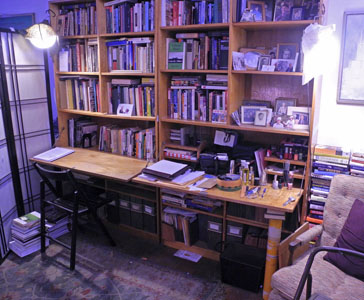 If you're a researcher
interested in visiting, to
work in my
library, I have great collection of books on numerous related fields. include eds. 3/22/01
3/9/04,05,06,07,08,09,
1/21/10 1/23 2/6 7/5 11/28
1/14/11 4/11 10/11 06/15 (note other ed.
dates indicate revisions of history of paragraphs or sections are) (P.F. Henshaw is the
pen name of Jessie Henshaw)
If you're a researcher
interested in visiting, to
work in my
library, I have great collection of books on numerous related fields. include eds. 3/22/01
3/9/04,05,06,07,08,09,
1/21/10 1/23 2/6 7/5 11/28
1/14/11 4/11 10/11 06/15 (note other ed.
dates indicate revisions of history of paragraphs or sections are) (P.F. Henshaw is the
pen name of Jessie Henshaw)
|
Some Favorite
Short Intros
|
General Reading
|
| |
|
or... skip to the main
Contents

An "earther" Cartoon
Collection..:-)
|
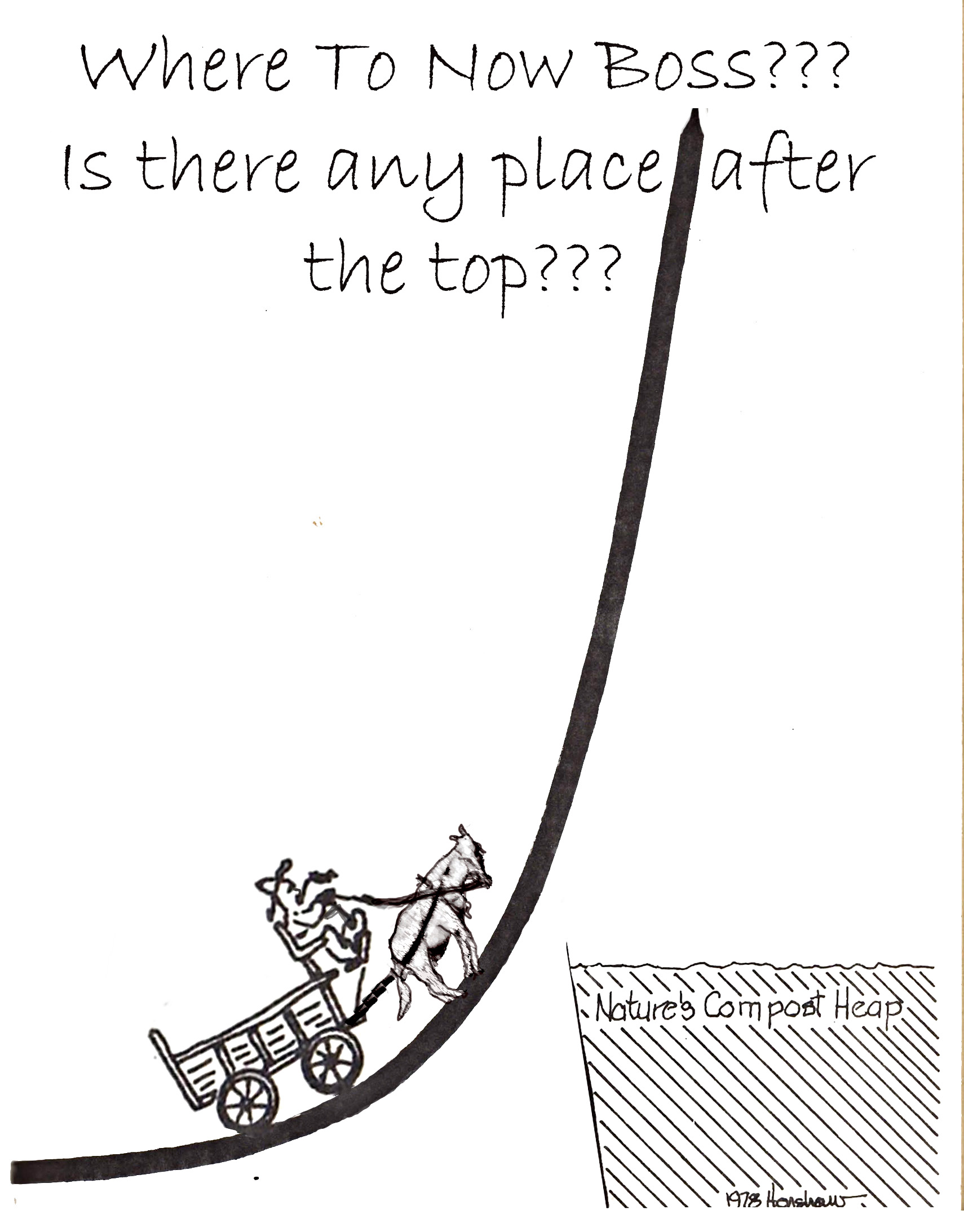 |
There's unquestionably something wrong
with a world society expecting to push the talents of its people and the
resources of the earth, our cultural resilience and her ecological
resilience, to absorb regularly multiplying scales of new
challenge and change. It naturally gets out of scale with
reality.
It gets out if scale by being a continuation of the path
we've been on, but now pushing everyone and everything to create and
adapt to ever greater change even as it becomes unmanageable.
So it now increasingly pushes people and cultures to acts of
desperation. It's part of our whole culture, though, and is
driven relentlessly by compound investing, the financial principle
followed for seeking prosperity everywhere in the world,
now escalating the challenges and risks.
|
| |
For a fairly simple reason it becomes a trap, because
the people leading society don't discover the illogic of it, because
they don't feel the illogic of it.
Increasing productivity by leaps and bounds had always been our ideal of
"good". It is perhaps the most unquestioned
belief of modern man.
To have THAT become a serious threat is deeply unexpected.
So only the people who can feel the counter-intuitive changes in the
realities, (feel intuitively that the "logic" of the system has become
"illogical"), are able to then maintain a motivation to search for the
evidence to discover the real root of our emerging conflict with our own
ideals.
the root of our emerging conflict
... with our own ideals.
jlh 12/15/12
From Blog Post |
| |
Emotionally proofreading your logical models
- a way to look at what this is all about
I've written several short "what this site is about"
essays, you'll find in various places elsewhere. They all attempt to
introduce a way to begin studying the eventful lives of the individually
organized and behaving systems of nature, our many kinds of animated
companions with which we share the environment . It's naturally quite
hard to understand what's happening inside a visibly eventful social group,
for example, though we may be intensely aware of its presence.
That also applies to much of the eventfulness of history in general, that
life is a place where "things happen" and often for relatively invisible and
apparently local causes. Any natural system is defined by its own internal
loops of relationships, is a way to state that as a problem, so for an
observer, the working parts of any animated system start off being largely
invisible.
From 6/29/12 Blog Post
One very powerful technique for probing the organization of
eventful and self-organizing cultural or economic systems is one I've rarely
mentioned. Maybe it's the one I should lead with, though.
It's a way of using your two natural modes of thought, intuitive and
rational, to "proof read" each other's work. It allows your feelings to
read and inform your reasoning and vis-a-vis.
The effect of learning how to do that is to create "theories
with feelings", and "feelings that make sense", something that is some
individuals achieve on their own, but is rarely if ever taught as a
practical technique. It's very valuable for connecting your naturally
"reductionist" explanatory thinking with your "holistic" intuitive and
experiential thinking.
 |
|
Finding the emotional content
in our logic driven world and the logical content in our
feelings |
It helps overcome the problem that explanations are powerful
tools but completely lack the responsiveness to their environments that
intuitive feelings about things bring out. Similarly, emotional
realizations maybe responsive to vastly complex sets of relationships, but
it's rare that people can derive their more practically useful logical
elements, what I sometimes call
"cybernetic body parts" that
I look for to use in explanatory models of self-organizing systems.
A business plan to use its profits to create ever more
profitable businesses, the "universal" business plan in our economy,
describes a logical model for an exceedingly complex interaction with an
environment that is missing from the model. To use your intuitive "right
brain" awareness of real world experience to better understand the "left
brain" model, you might think of business investment as planting seeds for
growing more seeds to plant.
That adds to the seemingly isolated abstract model, use money
to make money, a door to your rich personal awareness of changing
relationships and life experiences related to the planting of things to
grow. It opens up the complex issues of both their success in and
responses from the host culture in which they are planted.
Business investment is more than just planting seeds to then
harvest a crop of seeds, generating a surplus, like farming. In creating
businesses and the communities dependent on them, it's more like giving
birth to new long lived organisms, so perhaps more like parenting than like
farming. In either case, the natural "stewardship" issues regarding the
host ecology and the niche being used within it are simply missing from the
financial business plan.
Both farming and parenting work in relation to their host
somewhat like getting some fertile host pregnant, planting something to grow
in it, to tap its fruitfulness. When considerded as either parenting or
farming, ancient experience readily tells us that just getting the host ever
more pregnant is not a workable plan.
That unworkable plan the logical model offers, though,
represents itself as your quick route to ever expanding self-importance.
Any teenager can tell you it's as much a suicide mission for your future as
anything else. Many times people just are not in a position to ask those
kinds of questions, and will just never "put two and two together",
particularly when questioning the relatively blind choices they make that
seem to be most fulfilling.
Maybe it's one's ability to trust oneself to at least be an
honest broker for one's self, that allows the two sides of your mind to
prompt each other to ask the appropriate but sensitive personal questions
the other is blind to. Letting your feelings poke at the blind spots in
your reasoning or your reasoning poke at the blind spots in your feelings is
a lot easier to take than from someone, anyone, else.
Other levels of compassion, empathy, observation and
reasoning are needed too, to emotionally support yourself or others when
discovering blind spots have led to grave errors and so
grave disappointments, and the need to find some silver lining for relief.
For the standard business plan, the dark side of that blind spot is
realizing that what may a person's very most fulfilling life experience has
been, or is rapidly becoming, much more like a cancer of the generosity of
their host than a celebration.
The silver lining for that one is easy to point to, and if
taken to heart tends to be "the best is yet to come", as a distinct reality.
When we open up to our wider experience of life it's that moment when we
stop being self-involved and discover how to be responsive to the larger
world around us that is essentially the beginning of life.
That's readily observable in nature, for organisms,
communities and cultures of all kinds which have long productive lives after
their end of growth. It's generlly clear in hindsight that those long
fulfilling lives, creating and exercising their own discovered roles as
participants in their host environment, are far more important than the
brief explosive and formative beginning of life in their initial growth.
You don't normally get those sorts of insights into your the
wider relationships actually implied by the bare bones business model. Our
whole world economy is organized around that elemental
financial business model, without any apparent awareness of the complex
wider relationships that come with it.
It seems you only get an awareness of what a logical plan
really means in your life if you have some mental technique for putting the
logical model into an emotionally meaningful context.
|
The scientific subject here is
A
verifiable method for finding information missing from our
theories.
( & discovering the fascinating details of how real
relationships truly develop & change)
In a phrase, what's always
missing from our theories
is how nature puts together the continuity
of change*. That is verified by following pointers to apparent gaps
in our information that nature must somehow be connecting, and successfully finding what's missing. It's
often no more complex than asking when things started and when
they'll finish, maybe beginning with observing complex events occurring
with remarkable simplicity, like growth.
*except the other reason... the real difficulty
people have distinguishing between our cultural realities that
explain things to us and anything physically independent of them... seeing
our beliefs as stories of our own design that are often missing
the best parts of the real stories of nature is part of what
looking for the missing continuities of change helps expose.
As things change from "small" to "big" the
whole way they can change changes.
It changes their form both internally and externally...
Rather oddly, science doesn't generally recognize that most obvious of "natural
laws of change" because the subjects of science must all be defined and so only
concern "data". Natural change concerns subjects of the physical world
that had not previously been possible to define (SEA).
This conceptual "can't get there from here" problem begins a quite long search
for how to "wrap one's mind around" the odd true relation between the reality we
each we create for ourselves as what we "see" in our minds, consciousness, and
the reality of nature we are looking at as we make up our own. 10/17/11
|
The mysterious source of
the designs of natural systems
seems to have at least been
located, and found in the accumulative organization created by
their active parts,
that leave the arrangement of their inactive parts behind as the
design.
That seems to be the "genetic code" of
spontaneous self-organization. So,
what amounts learning by the parts of systems that
manage themselves, is what shapes the self-managing communities of
nature, including organisms and economies of many kinds.
This observation, well enough confirmed, rather
conflicts with the common model of modern science, though.
That traditional approach treats the designs of nature as the rules
that science finds in the organization of the inactive parts, or
just equations approximating their measures, overlooking the
accumulative learning of their communities of active parts that
created and continue to alter the arrangement.
They wouldn't fit an equation. The
active parts of nature have been represented, instead, as the
mathematical operators of our equations, as being determined by the
design rather than as the source of the design. That's
seems to be why science makes it look like everything can be
controlled. The approach doesn't fit the observed natural
world, but joining the two views is a real challenge.
Help or relevant references of any kind would be appreciated.
Effectively omitting the self-managing systems
of society and nature from our management plan for the earth, and
their active learning as the "glue" that shapes and binds their
parts, creates extreme contradictions in the plan.
So, traditional rules are in deeper question than one would expect.
It's
reading nature's signals to see what
our learning systems are learning,.. about how they are
finding to use our world, is what will tell us,
how to survive in community with them as our partners.
|
|
Complexity
- (in natural systems seen working as a whole)
accumulating
complementary relationships allowing them to work simply, or to fail.
To see the organization of natural systems takes effort, closely watching how nature does it,
carefully watching for how things can be identified as working as a
whole and changing as a whole. A culture or economy internally
communicates how all its members change their behavior at once, for
example. A building is built as a collection of
complementary parts that work as a whole, and are completed as a
whole by "finishing touches", as are business presentations, or the
preparations for dinner. They're all examples of natural
self-organization, by a process of finding and fitting parts
together, in phases, starting from a beginning and leading to a
completion.
It's the complementarities of new parts for the existing
arrangements that becomes a method of self-assembly.
Developing systems work by accumulatively linking their complementary shapes and functions; wastes to resources,
liquids caught by cups, savings to investments, etc., building on the kinds of opposites that connect
for the whole,
like the growth of organisms too.
Change over time in natural
systems occurs everywhere at once, which does not confuse nature in
the least. That it often occurs
in observably organized ways, like following smooth "growth curves"
is remarkable, and a useful tool for discovering the common origin
and its temporary systematic processes being exhibited. It seems inexplicable.
One of the most useful things to discover is what
parts it really are inherently inexplicable, having to do with
behaviors naturally hidden from view. It means that
predicting how they'll behave necessitates watching how they behave.
Studying the rich complexity of nature's most
beautiful processes also
enriches your appreciation of life. The economic value is more
for having early
warnings of change in the natural organization of things, letting
you adapt your models and expectations, and helps fill other
important gaps in your information. (continued)
5/12/2010, 5/22
Science hasn't
studied what animates individual systems, as they assemble their own
complex processes. Equations represent nature as
the predictions we can make. However useful that
describes the world as a lot of inanimate objects in controlled
relationships, only animated by our own laws and equations of
prediction, made to seem deterministic for our own purpose in
describing what we are able to determine.
continued
Deep Change in Reality
- The Reversing Productivity of Productivity...
How improving productivity always reliably made thing cheaper
and easier to do, is ending. It naturally ends as any direction of
progress does, if taken to its limit. Now we see our
"productivities" coming into costly conflict with each other and the
environment, making everything more costly and complicated, the
exact opposite of what we expect.
It reverses an expectation humans have had for how to solve problems
that appears to be much older than recorded history, as all of human
evolution is a record of great leaps of increasing productivity,
using less to get more. Becoming productive in
cooperating with our environment rather than conquering it, no
longer "productive", is a very big change in thinking for us.
Continuing our old model of "productivity" would make economies
completely unworkable, so very costly to operate that they
would become unprofitable, and have to cease working.
We're seeing a large scale version of how many ancient skilled
"problem solving" societies of the past created problems for
themselves they couldn't solve and environments that would no longer
support them.
Even
"downsizing" is hazardous, as economies develop by
accumulative design (growth)
and so "the new" frequently relies structurally on not changing the
old. A growth system's design becomes a barrier to its
own radical reorganization, causing decline to result in shedding
whole formerly integrated sectors at a time, and so "growing together"
but slimming down by "breaking apart", growt h
as "lifting all boats" to become "musical chairs" as the natural
response to pushing the limits.
That using productivity to grow the economy would
at a point rapidly reverse it's value to the economy, has been clearly visible approaching
for more than a century now. It can also help us turn our attention to the
right subjects.
#1
Sustainability Issue Today...
For philosophers, it points to a
fascinating case of a
Type III error, trusting the wrong model and accepting the wrong
questions it keeps giving us. For philosophers, it points to a
fascinating case of a Type III error, trusting the wrong model and
accepting the wrong questions it keeps giving us. We have been
treating nature as the models we make from the information we
collect. We haven't been watching, for changes in how the systems of
our environment naturally work by themselves. So it has left us "in
the dark" just because natural systems that work by themselves also
change by themselves, not reporting to us how. [posted
on RNS 1/24/12]
|
|
|
Contents
|
(Prior to work at the UN contributing to a commons approach,
2012-14,
and prior to taking a pattern language approach 2015) |
_____________
___________________________
|
bio
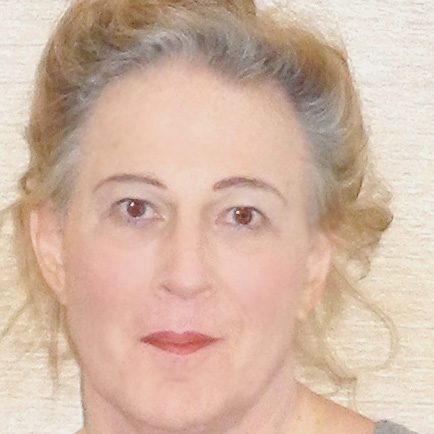
2014 |
|
- Two Important
Earlier Papers -
1.
Models Learning Change
Mar 2010
- systems physics for anticipating limits & costs
of delayed response -
Nature remarkably gives
each organism "its own mind", so their learning and responses count as much
or more for their success than the forces imposed on them. This graph shows
5 choices for when to respond
to an approaching natural limit. Given a natural "learning
rate" for how to respond, when to respond becomes very important.
That's like timing when to start an easy turn when driving or canoeing.
The craft's ability to turn is critical to estimate as it "learns" a new
direction, or else the turn will be too sharp to manage. The success
of natural growth systems or human relationships, businesses, or economies
all require responding to the approach of limits to growth, in time for the
system to comfortably adapt and reach them a peak of vitality, rather than at a peak
of exhaustion. ...
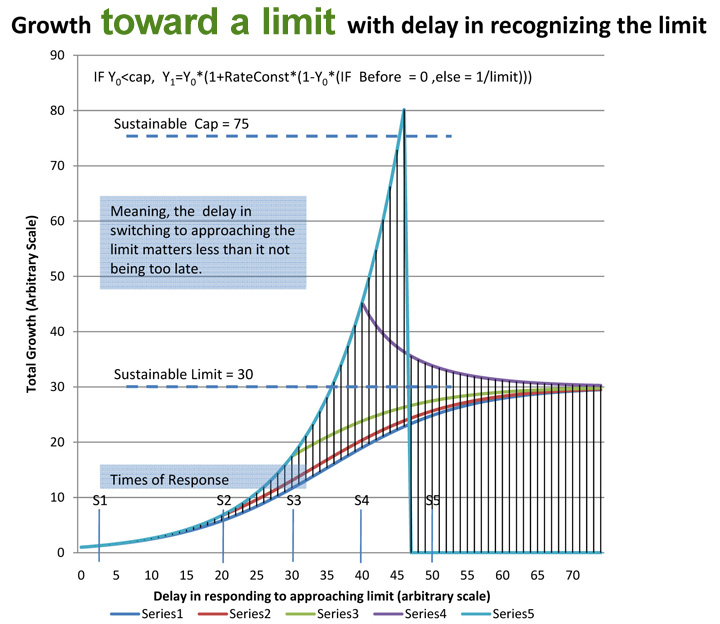
(click to enlarge)
The principle is rather simple, though the discussion in
the research paper is a bit complex, sorry. Once you learn that your real
learning task is to watch your own environment to notice when and how timely
responses to approaching change really matter.
Delayed response to
approaching natural limits risks exhausting your
options and losing
control, just like delayed response in turning a corner when driving. In home economic terms,
growth is like nature being pregnant and giving birth to a new
living thing, that will need care to survive. So endless
growth as a plan, asks nature to exhaust herself giving birth, and
abandon us with no budget for a home or child care.
2.
Systems Energy Assessment
(SEA)
Nov 2011
- how to count your responsibility for untraceable energy uses -
The self-managing
services we employ when paying for both consumer goods and services and to
operate businesses, are statistically hidden from view. They don't
report how they work, and so there is no data to use for them to include in
counting up the energy demands of business and purchases as environmental
costs. It turns out the energy uses hidden from view, for lack
of data on them, are commonly 80% of verifiable totals, and have been left
out of the study of how economies can be made sustainable. Among
many other problems, for example, the impacts of the (self-managing)
services paid for that have ever growing energy demands, are not considered
in making models of business sustainability.
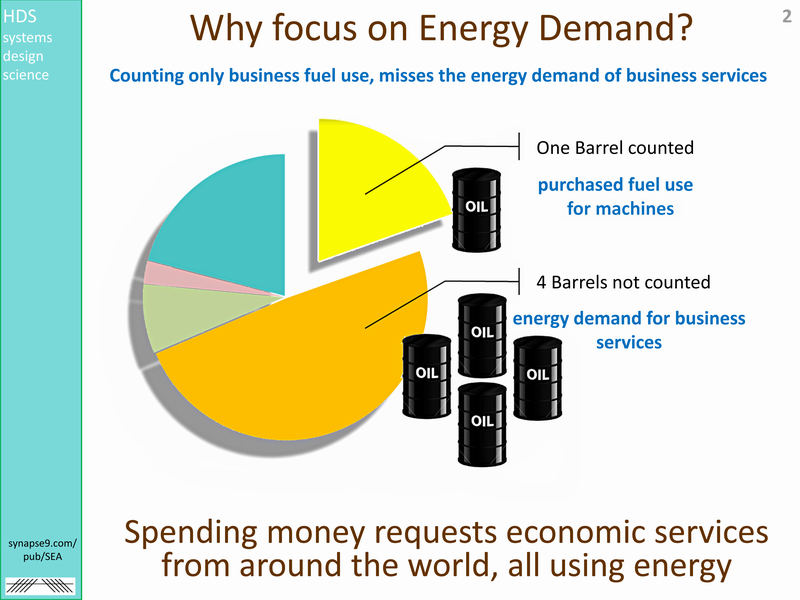
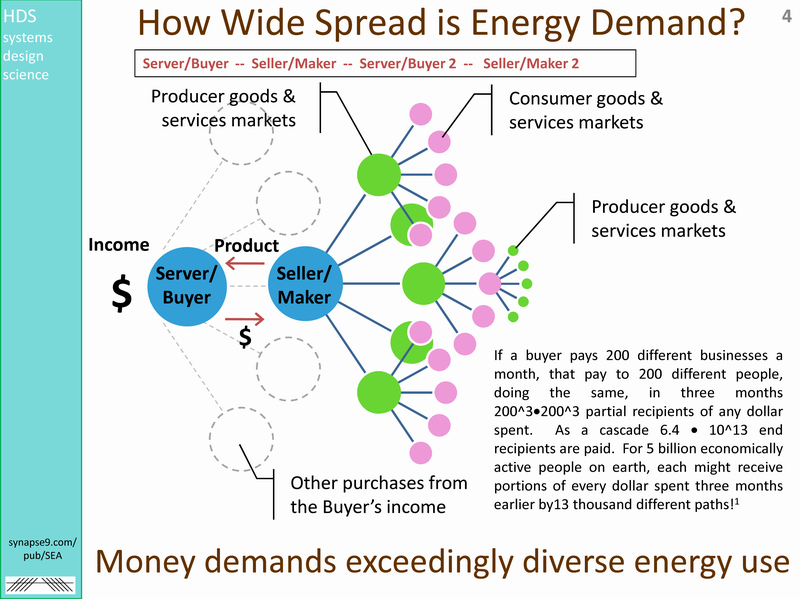 |
|
|
|
|
Tweets
- Shoudaknown -
@politifact re:#FLdebate You might fact
check if any of them showed an understand of why the economy is not behaving
as anyone expects? 1/24/2012
@politifact Why the economy doesn't behave
as expected includes how crazy what we expect is, that it should grow
forever with no difficulty.
1/24/2012
@politifact An odder belief is I=PAT, that
technology efficiency that first multiplied impacts will reverse them too!
synapse9.com/home.htm#ish1
1/24/2012
See
Archive
for others
|
|
|
© 1995-2012
reproduction, review and quotation encouraged with attribution. |
|
Reading Hints...
Try
just browsing for something interesting, there are lots of starting places...
Please
do ask questions about things that are not clear. I apparently
switch perspectives sometimes, without giving readers warning. I'd
like to know were I should have inserted a footnote to explain. Like
the "six wise men and the elephant", I may imagine you see the whole when I jump
around referring to various seemingly unconnected parts.
If some one said "Local
systems explore their environments for opportunities and develop individual
organization and behavior"
would you guess it meant a) natural systems all have
conscious thoughts??... b) they are ruled by spirits??...
or c) they develop and respond individually along natural local paths? ...
Short General
Introductions
What's so different here?
~3/28/09
Systems Theory is not
really the subject... but rediscovering a lost art of observation
Science
is all about observation, of course, but almost exclusively focused on
observations about how things of the physical world are externally controlled,
using controlled experiments, for example.
The
problem with that, of course, is that it makes learning how to observe the
things of our world that choose their own paths, and are significantly
self-controlled, into a lost art.
I
say "lost art" because our common languages are filled with terms for how
people, our cultures and communities, and other kinds of organisms of all sorts
of nature actively explore and steer their own paths in their worlds.
After you learn to look for it you find it's a fairly common property of natural
systems. For centuries it has been represented as something that happens
nowhere in nature except in the minds of the one self-conscious species.
That's just a bit of an exaggeration. It takes effort and a
playful approach to demystify it, but it's just a wonderful lost art in the end.
1/8/10
It's
not even "science" in a way, as science is a theory of how nature is controlled
and this is about how to explore the uncontrolled systems in nature.
Learning
is an uncontrolled system, for example, both for us and for nature.
It's
learning about the real mysteries of how ordinary things work using observation
to help find better questions about them.
(aided by some innovative physics and systems theory)
Understanding
what problems are unsolvable solves amazing problems is part of it.
Studying the flows of change exposes distinctly temporary systems, pointing to
what cannot continue.
Foresight then comes from asking the hard questions about what will upset them
and how they will change.
Then
you can far better predict their tipping points, as their fortunes change by
changing their own
environments,
to discover the unusual richly beautiful worlds of accumulating and upsetting
local designs
in the spaces "between the laws of averages"
where individuality
develops.
It's a way to learn about how
what persists in nature develops from what is temporary
as complex natural relationships develop,
finding their complementary connections.
Perhaps
that lets you become part of and make much better responses to them
during an age of stumbling over ever bigger mistakes,
trusting failed habits of the past and bad advice,
Finally
catching up on the loads of "back home work" on the story of life
we never turned in when we were younger.
Information
actually controls nothing but our predictions, but it's become popular to
redefine nature as being what we can predict.
What
leads you to understanding something
about the worlds of nature we completely rely on taking care of themselves,
is not prediction however, but using the same information to help you ask better
questions
about what must remain unexplained.
~3/28/09
8/30/10 This site
and my own explorations are about
switching one's orientation toward reality. It starts with recognizing our
common habits of explaining things use images we fabricate in our minds to
substitute for the real subjects of the world, a kind of short circuiting.
The alternative is to use our images to help show us where reality is different
from our mental picture. That orients you to being an explorer of
the real thing beyond what you can imagine. It's "counter
intuitive" in our culture to consider physical reality to be what we find beyond
explanation, but other than being quite factual, the benefit is that there is so
very much of it otherwise going neglected.
Science has mostly taken the opposite approach,
though, trying to find the features of the world that could be turned into rules
of explanation, often explicitly claiming that by explaining more and more we'd
eventually explain everything. It becomes a truly false
objective, to consistently avoid studying the things beyond explanation, like
how natural systems work with so many individually uncontrolled learning and
evolving parts. Needing rules for things means neglecting to study
how things take care of themselves, one of the most notable features of nature.
The sure sign of the gap is that the universal process by which organized
systems develop, growth, is not a recognized subject of physical science, and
evidence of an extreme blind spot. That growth is an environmental
learning process seems to be why deterministic science has neglected studying
it.
So, it takes a real admission of a kind, just to
study what we naturally can't explain about the world. It means
admitting that conscious explanations or "knowledge" is a kind of fiction that
leaves out more than it explains in practical fact. Our explanations
themselves are all human inventions, and they don't match the physical reality
very well when you check. It implies that physical reality is
located primarily in what we don't understand, and in what we find inexplicable
about the world. It seems to suggest knowledge in general would be
much more valuable if treated as questions rather than conclusions, and that may
be our mistake...
2/12/10 Appreciating
how uncontrolled systems make up their own rules as they go is about closely watching
them, identifying large and small cells of climate and economic
processes and personal or ecological relationships as they develop and change
form, like storms, technologies
and our friendship circles and the balances of nature around us.
There are their tipping points, approaching dead ends and emerging new forms to
identify. What usually marks their irreversible change, as
opposed to incidental change, are the patterns of successively bigger or smaller
steps of change. Those are what indicate developing or dissipating
environmental systems, the enduring structures of nature.
One develops mental models of them, but mostly as
questions about what's changing on its own. It would help scientists
to see what complex systems in an environment might be modeled, too, and when
the real system has or is about to change form and models of it will need to be
changed. It's about raising better questions, considering
natural systems as changing by accumulating new features as information in their
physical designs, as organizational learning processes themselves, made possible
by watching their conserved change accumulate . How to tell the ones
that are persistent and for which organizational change is strictly accumulative
and permanent is one of the important steps.
Considering natural systems as processes of
accumulating organization engaged in learning about their environments allows
you to view them as controlled by how they explore their environments and what
they discover, instead of as controlled an observer's rules of prediction.
A mouse explores its environment its way, to find food. A business
explores its environment its way, to discover markets. A teenager does to
find who there is to hang out with. Each is forms a network regular
connections, the environmental relationship itself, that serves as a platform
for finding new ones, establishing a presence in the environment and a way of
growing and responding to growth limits. Sometimes an observer
can see what they are about to discover, letting them anticipate what to do
then. The same stages of development and variety of outcomes for new
personal relationships can be seen in the life story of more complex
environmental systems like businesses or cultures.
Such new networks of environmental relationships
are "special machines", things that change form as they find room to
take off, and change form again when they run out of room. That's their
growth phase and maturation phase for systems that will persist beyond their own
initial growth. Normal models and theories fail to suggest how
such natural systems continually change as they interact with their changing environments.
Natural systems have distributed parts, and tend to change everywhere at once,
often in seemingly
coordinated ways and without controls. Sometimes they just "go zoom" in some
fantastically orchestrated way, for no apparent outside cause at all.
They're individually "eventful".
Their biggest changes in form come when they discover something and take off,
and then when their limits trigger them to either stabilize or run down. "Simple machines" don't do those
sorts of things.
"Simple machines" is all people and theory can define, though.
So this is about getting "simple machines" to point at
nature's "special machines", as better questions about them, helping
an observer to see their features
and learn to tell when they're changing.
 One
thing that points to them is their succession of progressive development trends, and
reading them as narratives of their organizational processes. Identifying
a local development trend lets you associate it with everything working together
as a whole to produce it, to recognize what's happening in total, and as changes
progress from one direction of development to another. It's whole system
learning from beginning to end. So there's the
art of
observation and the
general approach and
other topics. The rigorous scientific "hook"
making it a new scientific method is building the narrative around the sequence
of developments required by the conservation of energy for the physical continuity of energy flows.
The form of the narrative is derived
from
the Law of Continuity, which opens up a useful
new approach to general physics of change, consistent with thermodynamics but
not with some of its more common interpretations. Other physicists are still
generally
hesitant. The problem is how to treat scientific information,
whether as well defined representations of nature or also for referring to
physical things we can't define. It's a mysterious
philosophical conundrum, with a long history. Learning to separately
discuss physical realities we can only point to, not confusing them with
the information we point with... looks like the trick.
One
thing that points to them is their succession of progressive development trends, and
reading them as narratives of their organizational processes. Identifying
a local development trend lets you associate it with everything working together
as a whole to produce it, to recognize what's happening in total, and as changes
progress from one direction of development to another. It's whole system
learning from beginning to end. So there's the
art of
observation and the
general approach and
other topics. The rigorous scientific "hook"
making it a new scientific method is building the narrative around the sequence
of developments required by the conservation of energy for the physical continuity of energy flows.
The form of the narrative is derived
from
the Law of Continuity, which opens up a useful
new approach to general physics of change, consistent with thermodynamics but
not with some of its more common interpretations. Other physicists are still
generally
hesitant. The problem is how to treat scientific information,
whether as well defined representations of nature or also for referring to
physical things we can't define. It's a mysterious
philosophical conundrum, with a long history. Learning to separately
discuss physical realities we can only point to, not confusing them with
the information we point with... looks like the trick.
|
One
interesting question today is how to truthfully
explain, like "outgrowing our britches", why humans chose to
out grow our freedom on the earth, to maximize our constraint from
environmental conflict with the earth and each other. If
the physical measures show that 50 or more years ago there was a
turning point toward growing constraint and conflicts, as everyone
took ever more space, material and control of everything else,
why do we still act as if everyone taking more space, materials and
control over everything else is the solution?
- It would be good to answer that. It seems we're
following that path like a machine, or as if we were sleep walking,
not as would conscious humans.
1/23/10 2/6 |
| Another
question, from a very old version "Does all change Evolve?"
also takes you to the bottom of this long document so, if you like,
you can then scroll up instead. 3/22/01 |
Please do ask if things
are not clear. If I say things that seem to conflict with your
beliefs, ask why I might suggest it, or if I was just misspeaking
for your way or reading it. Sometimes I'm trying to suggest a range of possibilities,
sometimes I'm omitting something that should have been mentioned.
Let me know. We definitely have a lot to sort out in many ways.
T
he problem
with systems
....4/10/09
05/20 6/17 7/9
is that people don't recognize the
vastly complex natural machines by which the world works. Natural
systems don't operate by our explanations, and how they do operate is as yet
quite inexplicable to us. Natural systems arise from their
environments by local development, which is one inexplicable thing about them, and
operate without instructions or controls, using processes occurring differently
everywhere at once. "Seeing" things is to make sense of them,
so
No Wonder
we don't see them! We can begin to though. It takes
learning some strategic ways of reading beyond your information, and discover
the implied processes of sweeping change we are caught up in. The
key to foresight with them is recognizing the kinds of progressions that end by
upsetting the regularities they display (growth
 | integration
| integration  | disintegration
| disintegration  | decay
| decay ),
so you can learn to watch them to learn about change in natural system relationships has
or is about to happen. It's another way to read the fingerprints
of nature's transformations.
Traditional scientific theory is mainly used to build predictable models
that interpret nature's stable behaviors of the past, not to read nature's
instabilities for clues to her changing complex organized forms.
),
so you can learn to watch them to learn about change in natural system relationships has
or is about to happen. It's another way to read the fingerprints
of nature's transformations.
Traditional scientific theory is mainly used to build predictable models
that interpret nature's stable behaviors of the past, not to read nature's
instabilities for clues to her changing complex organized forms.
Mathematical
models are not prone to change by local developmental processes as natural systems do, though, and don't offer a way to
explain things that change in different ways everywhere at once either. What this approach does is raise questions about
when and how individual systems will change their behavior in the future and
lead to discovering the new models that will be necessary to make new sense of
them. It's "raw science" not "finished science", for beginning or
advanced research into any subject of change. It's also a way
to open our minds and learn how to follow nature's actual processes, rather than
just follow the kinds of simple (and lifeless) explanations for them our
thinking can build and make sense of, and maybe... let us
end our clumsy effort to control nature by attempting to make her follow our
explanations too. There's lots of things you can follow and
understand, that you can't really explain, and that's often enough to show how
to adapt to or avoid them.
A useful theory of environmental
systems isn't about answers, but pointing to where you should look to find them, only hinting
enough
at the answer you'll find there to begin the search. Where
this approach began was with noticing
odd things like how all experiments misbehave a little, and how economies are
designed to let everyone put money into the common pot, to then take ever more out, with no end in
sight... Along the way it takes discovering how to identify whole
systems by connecting all the dots that grow together, like all the cells in a
body and all the local features of the environmental niche it grows in and
builds around itself.
People
often respond "I don't understand", but that is neither a question, nor an
answer. Just add "yet" if you don't see how to proceed. Your questions about your environment are needed for this to work.
The best source of "connected dots" is not your theory, but noticing developing change
as it happens. That is invariably a sign of a whole network of developing relationships.
Try asking "where did things start" and "how are they going".
Ask "what's happening" and by "looking around" at everything your
issue touches learn to see it as a whole. Ask "where are the flows" or the
"eruptions of change" that connect things. Natural systems
doesn't make our kind of sense, true, so we need to learn theirs.
If you get stuck break your thought pattern, try flipping a question around, to
ask it in some entertaining backwards way, perhaps, then retrace. The
story here is about an exploratory physics of uncontrolled systems that any
field or level of interest could make use of, discovering how to discover the
naturally developing environmental relationships all around us. It's
about "the track" that people often refer to with phrases like their life
or work being
"on track" or the country going "off track". This approach lets you ask "whose track"
and "what track". It allows open minded explorers to enrich their view and
knowledge of the locally developing features of changing environments.
Natural
environmental systems generally have "variable organization". Nature's
physical systems are simply not sets of fixed rules, though having theoretical
rules can help you make guesses, see what is behaving differently, and explore
it.
Physical systems develop from the collective behavior of independently acting
and adapting parts. They come to act together as a whole through by all
acting opportunistically in complementary ways, with "the system" as
their special environment. Organisms are that kind of special
environment for their cells, as cultures are for their populations, storms are for their
individual currents, and technologies are for their many closely fitting complementary
parts. What's good for the horseshoe is good for the horse... All have that same basic organic design,
lots of independently different parts working in concert. You can recognize these
wholes, and explore their internal
relationships, using questions raised by watching their individual stages of developmental
change. Tracking things with any regular measure that reflects the whole will do,
energy, money, size or resources, displaying the basic turning points of a life and
hinting at others.
Natural
systems are illusive too, because people have some bad mental habits.
The most frequent is ask the wrong questions by confusing our mental images and
related cultural issues with the physical world of environments.
They're mostly all but totally different and unrelated. The
problem comes from tending to mistake our own information for the physical thing referred
to. A first step in "learning how to think" then, might be to study how to separate
what you "see" from what you're "looking at". One of those is in your mind
and the other isn't, one built of your values and intuitions the other physical
interactions. Becoming aware of the chains of connection in an
environment is by recognizing that regularly accumulating physical changes are
not in your mind, and do not need any explanation to be connected to each other
somehow. Then discover that they have continuities that identify them as parts of natural
processes you
couldn't possibly have dreamed up. You slowly learn to confidently point to
them, and discover why it's never possible to define them. When you look inside a
living organism you can never find what makes it alive, for example.
That's mysterious because living things are distributed systems of independently acting parts, and
most of the
"real action" at any moment is guaranteed to be somewhere other than
where you look!
If
that makes you say "cool!", you're on your way. Otherwise, "look
around", something will surprise you. One hazard of using scientific
models for representing natural systems composed of independently learning and
responding parts like environments and economies have, is that models have
no independently learning and responding parts. They are built using
variables representing measurements of categories connected in fixed equations.
As such they don't contain any representation of the real working parts of their own subject matter.
This means that scientific models make particularly ineffective operating
instruction manuals. They may be good at predicting but are not
designed for steering. It never mattered much before, when
environmental science was mostly just descriptive, but now that we have to run
things we find all our "operating manuals" are untested. Even
economic theory was used largely for explanations rather than operating
instructions, and never had to actually work before. Now that
we have to start thinking of using scientific models to steer all kinds of local
and global environmental systems through their collisions with each other, the
issue of whether systems of independently behaving parts can be controlled like
our models of them matters a great deal. My approach uses a
model of simple scientific questions anyone could ask, rather than predictions,
presented as if anyone could be doing their own original
scientific research, directly observing their own environment, relationships and
experiences.
The
basic question is "What can you know for sure when you don't know very much?",
and finding that the answer to that becomes a better leading question.
Where it leads is to questions arising from the classic story line, "the beginning to end",
and digging up the unique threads to be found along anything's path of "magical levitation" that
sustains it and it's relationships. So this approach creates a
story written in anyone's own language, knit together with some simple
principles of continuity in change, for use in discovering your own questions
about things changing around you.
Sometimes it reveals surprising and helpful realities that have been 'hidden in
sight', like the link between rules and environments,
and how they reflect
local systems of relationships. The key is
learning to
connect the continuity of irreversible changes in scale with resulting
changes in kind with the stages of natural development.
They help you see what
kind of change to look for having occurred in the past, and is sure to be coming.
1. Growth,
3. Stability,
5.
Decay.
2. Integration,
4. Disintegration,
0 Initiation
1 2
2 3
3 4
4 5
5 6 Termination
6 Termination
The
top sustainability issue in the world
today
Efficiency is
being used for sustaining growth not the earth,
Popular attention is being diverted from the real moral and practical issues,
...how to end the need for growth.
The problem with
our concept of
I = P • A
• T
is that it's really
I = P • A • T•
S
a
linear equation missing the hidden
'S' for productivity
STIMULUS, the main
purpose people use efficiencies for
making P • A = f (T, E)
reflecting
how
People use
Technology
to consume
Environment for
making Affluence
and more People
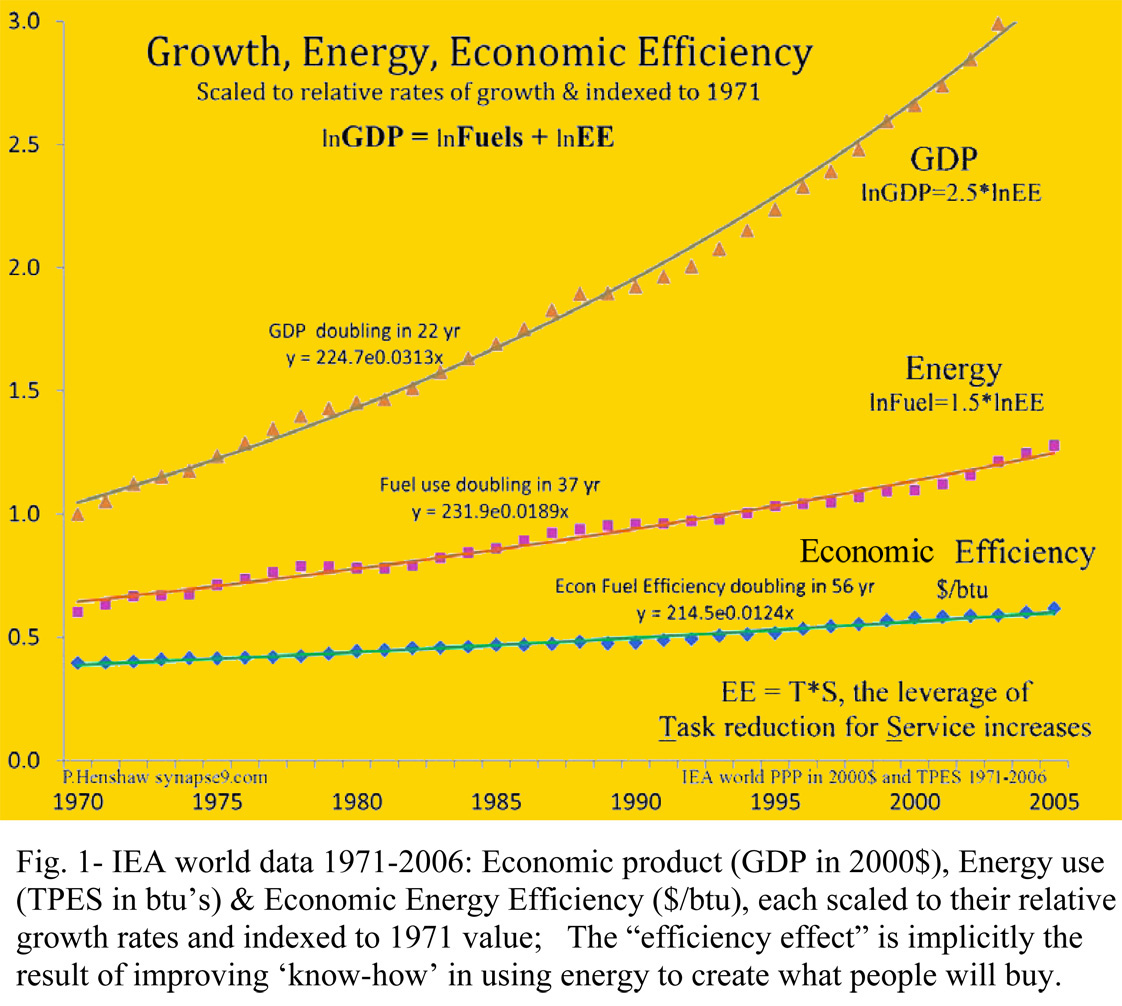 9/2/10
The curves at the left demonstrate
the oddly ignored 150 year old observation of Stanley Jevons, that
improving efficiency results in accelerating resource use.
He first noticed it in how improving efficiency for steam engines used
up coal faster. The problem is we mostly use efficiencies to simplify our tasks
and so make resource use more profitable, to become more affluent.
The "secret" of how it works is that the particular efficiencies we
choose to invest in are the very ones that for a small cost have the
effect of simplifying a whole system of parts, often with improved technology.
That causes an increased productivity of the whole greater than the
decreased needs of the more efficient part. That's called growth,
the redesign of production systems so they can use and consume more.
To achieve the opposite effect and be responsive to our strains on the
environment we'd need to bring growth to an end, rather than accelerate
it with more efficiency... We've let ourselves be misled, in
part, and stumbled into a natural misunderstanding much like early
doctors who applied leaches to remove a patient's "bad blood".
By believing that sort of myth for too long we're now slipping into
grave danger of creating development we'll soon be unable to
either maintain or replace, and a physical system bankruptcy of a
lasting kind. (...continued.)
9/2/10
The curves at the left demonstrate
the oddly ignored 150 year old observation of Stanley Jevons, that
improving efficiency results in accelerating resource use.
He first noticed it in how improving efficiency for steam engines used
up coal faster. The problem is we mostly use efficiencies to simplify our tasks
and so make resource use more profitable, to become more affluent.
The "secret" of how it works is that the particular efficiencies we
choose to invest in are the very ones that for a small cost have the
effect of simplifying a whole system of parts, often with improved technology.
That causes an increased productivity of the whole greater than the
decreased needs of the more efficient part. That's called growth,
the redesign of production systems so they can use and consume more.
To achieve the opposite effect and be responsive to our strains on the
environment we'd need to bring growth to an end, rather than accelerate
it with more efficiency... We've let ourselves be misled, in
part, and stumbled into a natural misunderstanding much like early
doctors who applied leaches to remove a patient's "bad blood".
By believing that sort of myth for too long we're now slipping into
grave danger of creating development we'll soon be unable to
either maintain or replace, and a physical system bankruptcy of a
lasting kind. (...continued.)
Talk
outline,
Draft paper "Stimulus as Constraint"
"Our lives begin to end the day
we become silent about things that matter." Martin Luther King Jr.
Those able to see these errors
need to be employed in helping guide the change. We need to fix this, and
other fatal errors still part of our thinking. please help
Lists of other top systems
theory issues and
sustainability issues - synapse9.com
|
Some quite simple answers for complex
problems... (by finding the
right question) 11/13/10 |
| Economics |
What kind of balance sheet does business need?
Many economists like
Herman Daly
and
Graciela
Chichilnisky
have noted that |
| Energy |
How business energy use is counted misses ~80% of
the energy being used.
Curiously what's counted is energy uses
for which there are traceable receipts, and the ancient habit
is to ignore the untraceable energy uses for business costs that
don't provide energy receipts. The true scale is found by
assuming the average amount of untraceable energy will be about the
average global energy use per dollar,... presto... the missing 80%. It's remarkable,
and it does check out! It means
revising worldwide impact assessment methods, like for CO2, rethinking where our
impacts come from, and making quite different energy choices as we see
the more accurate picture of what produces our energy problem!
--
DollarShadow notes
Whole system energy measurement |
| Wealth |
Free market economies can reduce our burden
on the earth by following the
natural succession from quantitative to qualitative growth.
To change from doing more to do it better and better follows the example
of other natural systems that end growth at a peak of vitality rather
than a peak of exhaustion. Our doing that involves changing the
use of profits from multiplying the scale of business to improving the
quality of our relationships with nature and each other. The
intellectually interesting part, first noticed by Keynes, is that nature
actually provides no other option. For individuals, the
natural limit to growth would otherwise be the speed at which they can
keep up with making ever more complex and conflicted decisions.
What we need to see quickly is the need to give it the attention now so
it gets done right. --
Natural Economies essay
Search this site for other links to it |
| A Complex World |
Escaping old assumptions... in a changing world.
Traditional ideologies that work well can efficiently organize a
society, but become dangerous traps
when they stop working. To escape one has to learn to trust
your own observation again, recognizing conflicting evidence without
judging it until you put the pieces together. The important new
observations won't make sense in the old social and cultural language...
Growth is supposed to solve all problems, for example, not multiply
them. So following the old beliefs, our society acts as if
problems caused by growth like climate change, can be solved by more
growth. Money has to multiply, but the earth can't, is a
good observation to make. Find the meaning later when you
can. We live in a world becoming numbingly complex for
everyone is another.
Too Complex to keep track
Wandering Minds
Models Learning
Change
|
|
How to
slow it down |
Resource efficiency improves cost and
availability... accelerating uses and
depletion.
It's actually a 150 year old and
very easily confirmed observation that economic growth and resource use are
accelerated by people adopting productive efficiencies. That theory
fit's
the observation.
Sustainability policy blindly and tragically ignores the main stimulus effect of
productive efficiency.
As the economy actually works, the ratio of stimulus to reduction is
2.5:1, a world average effect for saving of 1 gal. of gas of creating new uses
consuming 2.5 gal.
-- #1 issue in sustainability,
"Stimulus for Constraint"
Impacts
on the earth = Population • Affluence •
Technology
costs •
Stimulus
(effect of improved technique)
|
|
• • • •
better questions
don't end the task of finding what to do, but give you a more solid place to
begin
• • • •
|
What are Natural
Complex Systems?
__________
Particle, Atom, Molecule,
Organelle, Cell, Organ, Body,
Community, Economy,
Population,
Ecology, Life, Planet, Solar System, Galaxy, Universe
The Continuities
of nature arise with the local development of
Multi-scale Networks
of physical relationships
Acting as a Cell
with an internal Medium of
Exchange
And local
Marketplace
to internally Link its Hubs,
Which are themselves smaller scale networks containing their own Hives of activity
Surrounding
their own Mediums of Exchange,
Cells
on their own scale. that develop regularities as "Local Laws" of "Their Nature",
Small
Universes with original design and behavior,
Linked
together by sharing mediums of exchange with others, as part of larger scale
networks,
Whole
Physical Economies composed of independently behaving parts,
That
we may refer to as features of our information.
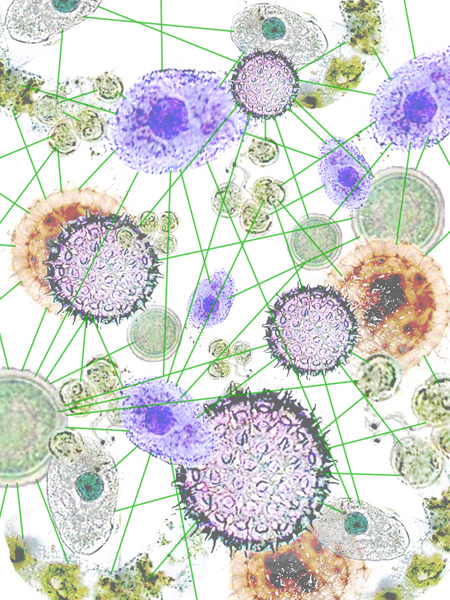 Complex
systems work by themselves, sometimes predictable, but determined by how their
processes develop locally. There are two realities, the physical
world and our mental world of human ideas, to be taken as dance partners rather
than as enemies, denying neither their freedom, and avoiding the denial that is
major trouble for both. At the scale of growth systems, at least, natural
systems
require diversity in their constituent parts and reserves of resources in their
environments. Those that grow also come to require stability.
Their creative hearts are the hives of network activity that form their cells, like the
village that creates the reason for a train stop and the reason for the roads
leading there. Those
hives of activity on any scale are where creative events develop to propagate
like seed on the
larger network scales, the process of emerging features that for a whole system "punctuates
the equilibrium".
Complex
systems work by themselves, sometimes predictable, but determined by how their
processes develop locally. There are two realities, the physical
world and our mental world of human ideas, to be taken as dance partners rather
than as enemies, denying neither their freedom, and avoiding the denial that is
major trouble for both. At the scale of growth systems, at least, natural
systems
require diversity in their constituent parts and reserves of resources in their
environments. Those that grow also come to require stability.
Their creative hearts are the hives of network activity that form their cells, like the
village that creates the reason for a train stop and the reason for the roads
leading there. Those
hives of activity on any scale are where creative events develop to propagate
like seed on the
larger network scales, the process of emerging features that for a whole system "punctuates
the equilibrium".
Bob Ulanowicz
has recently published a theorem on the need for diversity in natural
systems (1)
concluding "all complex systems, including our monetary and
financial one, become structurally instable whenever efficiency is
overemphasized at the expense of diversity and interconnectivity". What
drives systems to overspecialize, though, and develop their strengths until they
become weaknesses, is a broader issue. An example of this I’ve been studying is
why
people advocating sustainability are attracted to using efficiency as a growth resource, though that
ultimately creates instability as its end. It appears that it used to
have the opposite effect, and we got used to that. When we were
small and the earth was big, growth stimulated by efficiency used to make
resources more plentiful and cheaper. The economic theory of the
last two centuries, then, built up around that assumption. Now the
opposite is true, growth makes resources more scarce and expensive. If you look at the ‘green’ literature,
these days, you find that fatal solution for sustainability (sadly...) is really
all people talk about…
There are perhaps many
misconceptions that lead our society to reduce diversity, for profit, till
systems become unstable. I once devised a general solution to the
monetary part of the problem I called “general allocation theory”. I found it
hard to discuss with people. The barrier seemed to be the need to
discuss economic systems as individual
organisms of a sort, "creatura" as Gregory Bateson would have called them, like
self-organizing social or business networks as well weather systems and
organisms, each with their own individual behaviors. The still
dominant "paradigm" of nature for science is that there are no independent
systems, and everything that happens is determined by it's environment and
error, so writing other
better versions of that and other papers also received the same total lack of interest.
The preference is for representing systems with a set of rules of control.
The
natural systems approach is radically different in that systems are considered
as individual self-organizations that originate by growth and development, and
are full of different scales of independent internal activity, like what we
observe. Links on a network, for example, exist to connect
these ‘hives’ of complex system activity, like the road and rail networks that
connect homes, towns and cities, or the blood stream branches that connect cells
and organs. In economies there are the supply and product chains
feeding into goods and service markets that link the individual hives of
activity that individual businesses are. It's a really good "telescope",
something you can reliably find your way with, providing a great way to begin
making sense of natural systems by looking for their mediums of exchange of
different scale, through which their hives of organization connect.
1)
Quantifying sustainability: Resilience, efficiency and the return of information
theory
Ulanowicz, R.E. / Goerner, S.J. / Lietaer,
B. / Gomez, R. , Ecological Complexity, 6 (1), p.27-36, Mar 2009
2/7/09
2/12
jlh
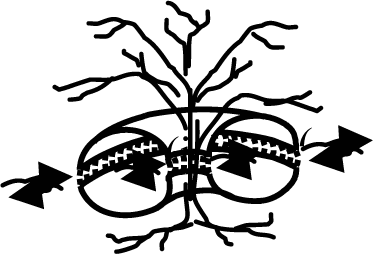 Physics
of
Natural Open Systems
*def note
0
Physics
of
Natural Open Systems
*def note
0  1
1  2
2 3
3  4
4  5
5 6
6
The
space between the deterministic laws where nature
develops animated
systems
Explanatory principles, for
locating and exploring their design and behavior,
and a way
to unify the languages of science around the natural world subjects they address
in common
The
problem of understanding natural systems is that they observably change
organization and behave by smoothly flowing processes, which are seen
changing everywhere at once all the time to do it... That's not like an
equation. I found a very productive new kind of diagnostic physics for
monitoring their organizational development processes, greatly aided by
finding them to normally develop as locally evolving autonomous networks.
The great advantage of the approach is that it allows
me to separately study nature's own complex processes and the theories we
need to help us predict and characterize them.
Recognizing those differences is the source of the most productive
questions that method generates.
Understanding comes from studying them as whole internalized networks of
relationships, much as if individual organisms with energy resource
throughputs. They exhibit periods of stable organizational development
that go through a natural succession of changing types, typically producing
inflection points in the empirical curves reflecting measures of their
processes where they transition.
That way the method builds on a combination of basic principles of
mathematical continuity, the physics of energy conservation and empirical
study of the natural successions of organizational development processes.
ed 6/12/13
Introductions
to General Theory and Applications
Intro
Essays & quick links
The
physical science origin
-
Physics of
Happening... an
archive from the 80's & 90's of the research studies that led to the analytical techniques,
theory & tools for this method of studying natural systems as
self-organizing events evolving over time.
-
Earlier work:
In the 70's I was doing a small
research projects on spontaneously developing energy transport
systems in homes,
air currents, and
found I needed to invent new concepts for how to explain their
evolution, as unique, individual, emergent systems of
organization (of great beauty and power) for moving energy that
spontaneously changed form... like "life".
That new set of concepts became a new form of physics, for
studying self-organizing systems of all kinds, as individual
cells of organization that had a development life-cycle
 .
.
While such
sorts of "viral" processes are generally associated
with all self-organizing systems, and are exceedingly common,
telling intriguing and important stories for us, but also
largely hidden from a deterministic world view. So
somewhat like a new way of seeing, it takes time to develop a skill with the
method. Locally self-organizing systems are not following an
external set of rules, such as the "lens" of
determinism is designed to look for. So... my
physics becomes a method of using theory to illuminate nature
rather than to reduce nature to theory! ;-)
ed 6/12/13
The
Emergence of Natural
Systems,
by Uncontrolled Complex
Learning of, by, and for
Distributed
Natural
Processes
05?
07/04/06 5/26/07 2/2/08 3/3/08 1/7/11 4/14
...Using physics tools as a naturalist would, for studying
how physical processes develop by themselves,
a study of individually occurring systems, their
internal networks,
their life histories, their current and future organizational development processes,
as the natural subjects of science.
1/29/09
11/28 4/14/11
Note:
My first successful expression of this
idea was in old unpublished early paper called "An
Unhidden Pattern of Events", the same
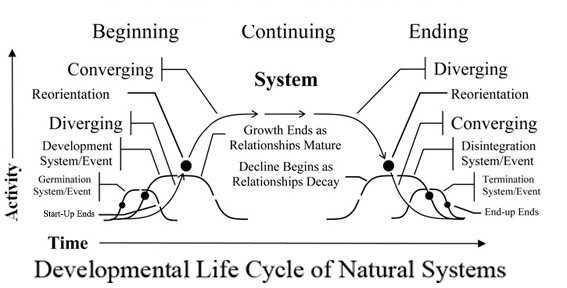 "canonical
development trajectory" was also described by
Stan Salthe as a universal
thermodynamic process in his 2005
Energy and Semiotics. This common
succession of events in the continuity of " development and decay" as the "life
cycle of natural systems" provides an outline, or a 'crib sheet' if you will.
You use it as a framework for filling in the details in the "Chapters - In the
whole story of individual lives and events" that any individual
case of natural system development and decay will be found to exhibit, as
necessary to satisfy the law of emergence and continuity,
for energy using
events and processes to begin and end. Below is
one introduction to my approach, expanding on the scientific method to discover
nature's "other theories", the innate languages of organization that develop
within natural systems, and how that makes many
new kinds of scientific discoveries possible. It would also seem to offer
a more deeply grounded
understanding of the realities surrounding us and with in us. The following two short discussions are still
useful, but "in a nut
shell" might work too.
"canonical
development trajectory" was also described by
Stan Salthe as a universal
thermodynamic process in his 2005
Energy and Semiotics. This common
succession of events in the continuity of " development and decay" as the "life
cycle of natural systems" provides an outline, or a 'crib sheet' if you will.
You use it as a framework for filling in the details in the "Chapters - In the
whole story of individual lives and events" that any individual
case of natural system development and decay will be found to exhibit, as
necessary to satisfy the law of emergence and continuity,
for energy using
events and processes to begin and end. Below is
one introduction to my approach, expanding on the scientific method to discover
nature's "other theories", the innate languages of organization that develop
within natural systems, and how that makes many
new kinds of scientific discoveries possible. It would also seem to offer
a more deeply grounded
understanding of the realities surrounding us and with in us. The following two short discussions are still
useful, but "in a nut
shell" might work too.
Recent Research Papers
| |
|
|
|
2011-3 |
A decisive moment for Investing in
Sustainability |
- A discussion of the turn of events represented by global resource
demand apparently exceeding supply on a long term basis, and the way
that upsets all the "natural laws" of economics... accepted for
New European Economy |
|
2011-2 |
The
Curious use of Stimulus for Constraint |
- A study of the odd general use of growth stimulus
for slowing growth impacts... to explore a method for looking at
natural systems from inside and out, and defining useful energy
budgets for their evolutionary processes accepted for E:CO |
|
2011-1 |
System
Energy Assessment (SEA) |
- How to define whole individual complex
environmental systems, as physical subjects of science, fixing a
~500% error in carbon and energy impact measures form not accounting
for businesses as whole working systems, for
Sustainability |
|
2010-3 |
Models
Learning Change |
- Methods for identifying irreversible organizational
development processes to anticipate new models for natural system
change - for Cosmos & History pdf
copy |
|
2010-1 |
Complex
Systems |
-History & open Issues for the broad
spectrum of complex systems science theories and application methods
- for the Encyclopedia
of the Earth, pdf
copy |
|
2008-2 |
Life’s hidden resources for learning |
- Discussion of how systems with learning parts differ from systems with
controlled parts, in Cosmos & History special issue on "What is Life"
|
|
2008-1 |
A General Law of Emergence and Continuity in Change |
- a mathematical physics theorem
that
identifies the place of complex
systems in maintaining the continuity of natural events |
|
1999-1 |
Features
of derivative continuity in shape |
- Methods for identifying emerging continuity of systems from time
series data, for a special issue on invariants in pattern recognition, IJPRAI,
|
1.
11/08/08 1/6/09
The general subjects of dissipative systems and complexity is are not
really new, and really vast. What's new here is the recognition that
individual systems that begin and end do not need to be approximated by
deterministic models in order to explore their changing local organization and
developmental behaviors. Determinism is a restrictive assumption of the physical sciences,
based apparently on the guess that because some things can be determined from
other things, therefore nothing has
independent learning or behavior. This is about learning how to
study systems with clearly independent learning and behavior as a naturalist
would, but using the tools of physics to identify the learning processes of the
complex systems they contain and are the environments they interact with.
The starting point
for applying the physics of change to natural
systems (i.e. use deterministic principles to raise useful questions for
understanding non-deterministic phenomena) is with the universal limitations for
natural processes implied by the conservation laws. These are 1)
energy budgets for any closed boundary (2011-2)
and 2) the
necessity for processes
of multiple scales of organization for energy flows to
begin or end (. That conclusion comes from the old problem that when theory implies infinite field
density, rates of energy flow or accelerations, the real implication is of
another scale of organization. A theorem expands the conservation laws
into a general that identifies natural necessities
and limits of developmental processes, and opens a new way to explore
causation.
To apply the continuity & divergence principle to complex systems research
one uses the principle backwards from the normal procedures of physics.
It becomes a diagnostic tool for exploratory learning, that helps locate and
identify the 'little bangs' and 'big booms' of locally emergent developmental
processes. Development in a process, say an ionization cascade in a spark
or other growth phenomenon is called 'learning' because it is not guided by
rules or a map, but takes place by local exploratory interaction with an
environment. That successes in that tend to be exposed by how they
multiply provides a guide to where successful strategies within the system are
developing. It leads to a diagnostic approach to physical
systems and change rather than a representational approach. Work on
the method was begun in the late 1970's and now is collected here, with methods
and applications discussed in "a physics
of happening" section.
From an information theory view, a diagnostic approach to physics treats the
physical system as a unique individual "in-physico" model of itself...
The empirical signs of organizational change point to the physical phenomena
within and around it, which are together considered to be the full complete and true
representation of the system, in the physical thing itself. Then one explores it's features and shapes to
inform one's questions about it. A 'theory' that may develop for it
is considered to fit the physical thing's shapes like 'a glove' fits (or does
not fit) to 'a hand'. It's an
approach of trying to understand individual things that nature has already built, by developing
better questions about the process by which they developed. It then leads
to questions about what new
conditions it will confront and need to respond to as it develops further. The conserved
property of derivative continuity allows one to do that by connecting inflection
points in its
learning curves with the internal network of its system of relationships,
their learning processes, and the
environment they are responding to.
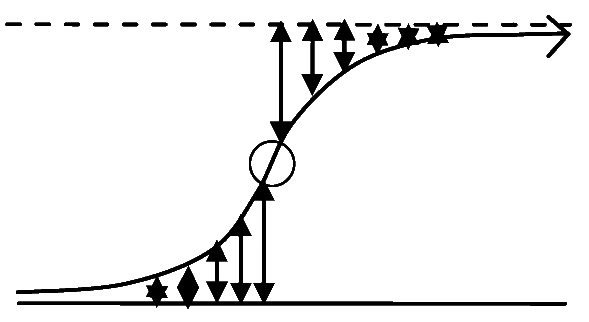 Typically
there is a switch in the kind of development between a starting period of
discovering expanding opportunity for self-referencing change in relation to the
conditions the emerging system is coming from, without limits, to
responding to and integrating with the limits of a larger environment it is
emerging into. The system development alters its original conditions
of development and other independent things in the environment often
independently respond.
Typically
there is a switch in the kind of development between a starting period of
discovering expanding opportunity for self-referencing change in relation to the
conditions the emerging system is coming from, without limits, to
responding to and integrating with the limits of a larger environment it is
emerging into. The system development alters its original conditions
of development and other independent things in the environment often
independently respond.
"How can you see
there's a process when your information about it is 'between the dots' ?"
2.
11/08/08 1/6/09
It's in the continuity of the dots. Unfortunately,
partly because of the many years of representing learning systems as following
other kinds of abstract deterministic rules, there are a lot of 'tricks' of
reasoning to unlearn. One of the key ones is about reading beyond
one's data. The rule of the physical sciences has been that science must
only consider the information it has as representing reality.
Physical systems, though, still exist in-between the times when you have
information about them. Here the gaps in your data are treated as
questions, not exclusions, and a continuity of change is what your probing of
the environment is seeking to uncover. It's proof by discovery, not
prediction. That's very different.
3/3/08
Every 4 year old child knows that
frogs jump because you poke them. It would be nice if the philosophy
of science did not still rely on that idea of causal determinism. The
idea that careful description of how actions of one kind produce effects of
another is sufficient 'natural cause' for how we determine our own effects is
perfectly sound. That we say our models of deterministic prediction
are also invisibly 'embedded' in the universe as the direct causes of nature is
not. The truth of course, is it's the frog that jumps, not
your finger. Looking at the time lags between stimuli and
response, you can actually prove that the jumping of a frog is a local complex
system learning process.
A
natural systems approach has to do with watching very closely as the 'frog
jumps' to observe how that learning process develops, and identify the
emerging organizational networks that are instrumental in the frog's
behavior. It's not about designing an 'artificial frog' as normal control
oriented science would be. It's about discovering how to read the internal
processes of the real frog. There are a number of important
discoveries about the true sources of eventfulness and organization in nature to
be made, including how a lot of it is 'hidden in sight', disguised by our own
unthinking categories. I have a collection of basic
principles:
Lists of Key Principles for understanding Natural Systems
Common Sense -
Basic Theory -
Systems Thinking
- Research Methods
12/07
My main collection of analytical work on studying the continuity of change to
raise key questions about the evolving systems of change is a Physics of Happening.
I built the collection of studies in the late 80's and in the 90's, and have
been trying to find the
right words to explain it ever since. To me, looking at historical
records for when, where and how developmental processes changed direction is an
obvious short-cut for finding the physical systems involved. I
closely observe time traces to see what's happening, focusing particularly on
where events begin and end. Where continuities begin and end the growth &
decay of the internal networks of relationships that do it is very exposed. Physics has looked at
nature and asked what universal rules are being followed. This
approach looks to see what local rules
are being developed. Certainly it may look a little strange to study
individual things rather than large classes of similar ones, but it's a key to
understanding the physical world. This intro has been rewritten many
of times, the following are some short topics that didn't get erased....
Notable achievements?
There's a list of what I consider important results,
but the most valuable for our steering the earth are various methods of
measuring whole system
strain and impacts. In well connected economies money does
actually quantitatively measure physical energy use for example. Money is
a 'marker', yes, of potential energy, because spending an average dollar
consumes an average amount of the total energy in global competitive markets
with energy price liquidity. This has a gigantic implication for economics in that most
of our long range economic planning assumes the opposite, failing to count the
'fat tail' of the impact distribution of spending. Using the
$shadow
principle to compare the measurable and unmeasurable portions of the impacts of
commerce shows a typical undercount of a factor of 10.
The
property of infinitely smooth progression in mathematics is called 'derivative
continuity'. It is one of the most fundamental and useful properties of
mathematical functions. Physical systems often display a similar
but less well defined property, call it 'flow',
or 'natural
continuity'. It characterizes the physical processes
in which change takes a process of change, and so is 'conserved' in the same
way energy can not be created or destroyed, only transferred by a process.
It's the main property of nature that
formulas attempt to emulate, and the main reason equations are useful. Energy
is among the few properties of nature that is universal and conserved.
Most properties of systems of organization are not, except... the continuity of
their changing. That's very useful. The natural continuity
of flows is more complex than equations, continually changing as the underlying
complex systems continually change. For example one section of a curve
might have all derivatives positive and a following section of the curve having
all derivatives negative. That suggests looking for underlying
systems and how they switch from growth to decay.
The
intent is not aimed at writing a formula. You might use a formula as a way to
see how the natural system diverges from it, though. The intent is to
understand how the instrumental systems develop and interact.
Reading shifts in the continuity in natural flows is a big help.
It's an approach that works with any field of science, astrophysics or
political science, ecology or economics. Each would use it to study
the continuity of change of the properties they are interested in for the
systems they are interested in. Making it possible to have a common
empirical reference to the qualitative subjects of interest
greatly helps in 'getting the problem right', whatever analytical method you
then use.
One promising method is to us
network science
, starting with mapping networks of internal sets of working parts of
whole complex natural systems, and then reading their learning curves for their
whole system environmental experience..
My
sample studies use various mathematical tools
in a diagnostic fashion, to expose otherwise hidden details of physical
system flows and the implied system developments they reflect. One of these is called "derivative
reconstruction" (DR) that uses the mathematical definition of derivatives
in reverse, to "reconnect the dots" and sensitively reconstruct the probable dynamics of
underlying system by filtering the spurious higher derivative fluctuation.
Another constructs a "dynamic mean" (DM) by stripping fluctuations and
reconstructing the simplest curve shape representing their norm. They
produce differentiable natural functions by interpolation. It doesn't
always, but often exposes otherwise invisible
developmental changes and forces excellent new questions. To assume
that a series of dots represents a single continuous process is tricky, of
course, and there are some statistical tests like the step variance test (SV)
to rule out random walk and a noise suppression sensitivity test (NSS) to gage
the scale of non-random fluctuation. Another of the methods used is called "curvature scale
space" (CSS) which originated in the field of computer vision.
It uses repeated smoothing of shapes to distinguish and define those
features of shape which are the most robust (slowest to disappear with
suppression). Basically you look for where processes begin and end
and try to figure out what is beginning and ending.
There is no
practical barrier
to these new methods having wide and immediately useful application in
numerous fields. There is a conceptual barrier though.
It's not the Western cultural habit to think of time as a process. We
tend to think of it as a location, and so equations with time as a variable as
describing a system that itself does not change over time. The
evidence is that all natural systems continually change over time, and that the
main events causing change in systems are 'tipping points' at which systems
'out of balance' end up disrupting themselves in some fashion. Ordinary thinking hides
that from us.
The
Art of
Observation
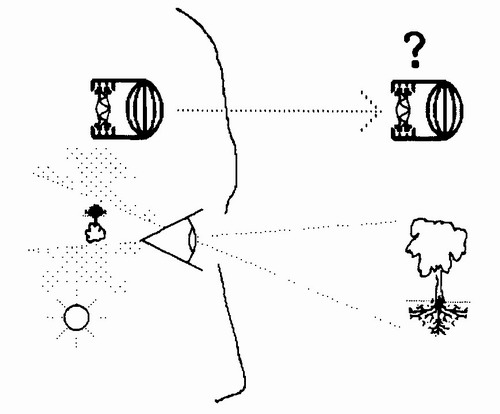 12/28/08
1/24/09 1/27 1/20/10 There
are two things required for learning how things in nature work on their own.
One is observing them without thinking, so your mind records some marks of the
original behavior in a highly faithful way. The second is exploratory.
Exploration is a matter of finding threads of connection and following them, and
for natural systems, then letting the connections "grow on you" giving you "new
ways of thinking" to check out. What you're looking for is
ways nature thinks differently from the way you do, paradoxically, so you can "be
of two minds" about them. It's becomes a way of
connecting the dots that raises useful questions you never thought of before
prompting further observation.
12/28/08
1/24/09 1/27 1/20/10 There
are two things required for learning how things in nature work on their own.
One is observing them without thinking, so your mind records some marks of the
original behavior in a highly faithful way. The second is exploratory.
Exploration is a matter of finding threads of connection and following them, and
for natural systems, then letting the connections "grow on you" giving you "new
ways of thinking" to check out. What you're looking for is
ways nature thinks differently from the way you do, paradoxically, so you can "be
of two minds" about them. It's becomes a way of
connecting the dots that raises useful questions you never thought of before
prompting further observation.
That, in a nut shell, is what "science" is, with
one key difference. This is about discovering how individual systems
discover their own rules rather that all compelled to follow preexisting
universal rules. One
way to tell if it's working is whether you find paths of discovery that lead you
on, little "yellow brick roads" in nature, taking you beyond your prior imagining. That
also helps you tell if you're just making things up
or really discovering the nature of what you are looking at. That's an endless hazard
because of the human tendency to interpret consciousness as reality, instead of
our own personalized cultural image. Observation is pure
research. Then, you hope your way of
asking better questions gives you a way to talk to others who have done the same
thing, in their own different way, so you can constructively trade notes.
Figure: The diagram is of 1) how seeing a tree leaves a direct imprint on
the retina of an observer's eye, 2) in who invents in their mind an image of a whole system
through which energy and materials flow like a tree, along with an image of how it
is connected in the cycles of nature.
Is the diagram to be found anywhere in nature? No, of course not.
It's imaginary.. Is it may also be useful for helping the observer
ask better questions about the real tree and it's environment, that others may understand
as well.
Possibly... --
Why people seem to know so very little
about how the intricately organized things of nature take care of themselves
gives the appearance that humans have not learned much from our time watching to
see how things around us work. Our normal rule for
explanations is self-consistency, that every piece of information is determined
by some other piece of information, and nothing in it has
any independent behavior. The better question would be, if some things in
the world seem controlled like that, why isn't everything? Asked
another way, it might be, why do people almost never ask that question?
That there do indeed seem to be at least some things that take care of
themselves, but we hardly ever ask how, seems to be a possible reason why we have
such mixed success in taking care of ourselves... It comes down to
our habit of treating the *things* we see as the *information* we have about
them. Things may actually talk back, and information never will.
Seeing them as information we then interpret the things of the natural world in
terms of our explanations. The inadequacy of that is not only how
explanations are never going to talk back, and the things being explained very
well could. All the connections in an explanation are also things we
added ourselves, not things that came from what we're explaining.
What we use to connect the pieces of information to make explanations stick
together are the cultural and emotional values we attach to the information.
In our minds we don't see physical things as connected by the physical systems
they are composed of, but by the value laden constructs we attach to the
information we have in our minds. We tend to equate the real world
with a kind of "dream world", our own artificial representation of it.
How we see things as being organized is as we organize our
own thoughts and values. We don't see them as organized by the natural
processes that produced what we see. What a true observer needs to
overcome is this naturally artificial naive viewpoint, that the things of the
world are the images we have of them. It's often not easy, but there are
lots of little flaws in the 'magic' of how we disguise the world as information
you can learn to trust, leaving openings to the real world where you discover
connections rather than fill in explanations.
Observing is a process of letting the intricate
beauties and designs of nature seep into one's awareness without imposing
your own cultural values or explanations on them, to remain free to discovering
their own connections. When later attaching ones own values to them, then
it is to something of substance rather than to nothing of substance. Otherwise
observation tends to be just a fascination with your own values. Often
where you make your first discoveries of nature's connections is noticing how
things act as a "whole". It's the best indication of the
existence and design of uncontrolled systems, that they have complex scattered
connections that act as one. The easiest place to see it is in any
organism, or culture, or burst of chemical energy, locating the system by how
its set of scattered parts erupts in growth as one. What you soon
find is that what makes them whole, and gives them their ability to act as one,
is what I call "ESP" (equal stress principle).
Things that act as a whole tend to evenly distribute their own stresses
internally. Seeing this can be easy for some things, but quite hard
particularly for things we only know from other people's explanations.
Explanations don't do well with uncontrolled parts. It can be a lot
easier with things that need no explanation or come naturally and are beyond
explanation, that we know intimately and so can closely observe without bias. Truthful
observation is not a "one shot deal" but an accumulation of them.
It's like building compost in the soil of an organic garden. It's a matter of
letting one's own mind accumulate a rich compost of the unaltered features
imported directly from the "value free" physical systems of nature, letting your mind become imprinted by them as the first step.
A painter needs paint, and a good observer needs to let
their 'paints' accumulate in nature's own colors. Not taking that
approach, but seeing things as the information about them we connect in our own
subjective way, our observations then tend to represent the world as lifeless
and formless. Things become "just explanations", given meaning only by the values we attach to
them. We miss all the natural meanings they have that way. What we then "see" is our own
poor awareness of how
other things work on their own. Then in everything we see we find
mainly reflections of ourselves and little of the natural world's own connections. It's an
'inadequate'
view of our extraordinary rich intertwined and living world with its many kinds and scales of
organized and complex individual parts. Whether it's the health and
prosperity of a tree, of a storm the size of a planet, or of a personal friendship or community of
relationships getting into trouble and painfully hard to understand, the beginning of becoming truly a part of it's future is truthful
observation.
I have lots of accumulated notes on observation technique scattered all over
these pages. I've been learning how to express it better, which of course
means nearly everything here is also a little "out of date" and in need of "fixing" a
little. So, poke around...and see what you'd use and what you'd fix.
Network
Science
....what happens when things connect!
05/24/07.. 09/09/07
Watch this space....
The NetSci conference in NY
in May 07. The ability to convey highly complex system information and
understand the evolution of systems from it is advancing to a useful tool very
rapidly.
Great Displays
from Manuel Lima's Visual Complexity. My most recent technical notes
on linking Net Sci and Natural Systems Theory (*def note*) with Complex Systems engineering..
PICS.htm
-
One of the things that causes the 'power law' distribution of
organization in emergent systems appears to be the elaboration and refinement
that occurs in how they grow and develop.
-
One of the ways of understanding how networks are embedded into
the complex systems which produce them is hat all the nodes are actually 'hives'
of activity in the larger system when looked at at a different scale.
-
To understand what it means that people are connected by 5 degrees
of separation and web pages by 19 is helps to consider how close connection of
this kind has a simultaneous reverse property of great isolation and
independence. What the difference between 5 and 19 means is that
information is divided into many many more separate worlds, the flip side of the
astonishment we all feel when finding out that all our very separate worlds are
also quite closely connected.
The tools for displaying these structures and relationships are so
good, and the complex system decisions people need to make so pressing, that
there clearly should be
an office of
complex information display in every branch of government.
You can't ask the question till you can see
the problem. Think of the difference if we could look
at comprehendible maps of the real evolving complex relations between
communities in Iraq or your own city! It's clearly possible
now. Think of the difference if we could map ecologies in depth and
display their connections in a visually compelling and analytically rigorous
way. It's clearly possible now.
General
Systems Theory
....a grand event in
systems thinking that didn't survive,
05? 07/04/06
General
Systems Theory, was one of several
great attempts to make a science of the study of natural systems.
The more popular but still unproven one today goes by the name
'Complexity'. GST originated as a major
interdisciplinary effort in the 1940's, Von Bertalanffy,
Boulding, Ashby, Miller, Forrester and others,
and seemed to loose direction and turn into other things in the late
1980's & 90's. The language of general systems theory as it
developed, is problematic as science and quite short on
generally useful results. Still, it is full of insights
into the nature of the problem.
The successor organization which
retains little of the original form keeps a web site with a genealogy
diagram of systems thinking (http://www.iigss.net/gPICT.pdf).
Basically, 'holism' became 'cybernetics' and with several layers of
complexity became 'general systems theory'. I've had recent
long and productive correspondence with Don McNeil
about the origins and 'death' of pure systems thinking, and what might be
salvageable. I thought it might be of some research interest sometime,
and asked if I put it up on the web that I show it as copy righted. My
two 1985 papers for SGSR and some other things are
now online too.
All natural systems are an interplay between active and passive components, for
example. There's the plant and the soil, the cell and the blood stream,
the speaker and listener, the industry and the pools of resources from
which it draws and to which it contributes. Nature is also structured as a
unity of opposites, things and the mediums through which they communicate
with each other, for one example. These and many other insights into
nature are mystical in their power, but also overwhelming in their
grandeur while failing the test of having practical use. It left
those who studied it relatively less to say than it first appeared they
would have.
The 'Physics of
happening' is a general science of systems based on close empirical
study of the same physical subjects as GST. I
did a quick study of the GST citation rates
for the terms 'general systems' and 'general systems theory' on Google
Scholar from the 1930's to the present. The measures
show a combination of effects, but tell an interesting story.
There's been a continued explosion of the use of GS and a hint of climax
and decline in the original use of GST.
It's just a very fast stucy I haven't been able
to follow up. ed 6/23/06
Natural System
Economies - compulsive capitalism v. natural growth
...(it's
about
what you do with
profits!)
05? 07/04/06
08/25/08 3/31/10
Keynes
was a misunderstood systems ecologist too... and there's a trail of evidence
that he discovered the secret of how natural systems switch from multiplying
complex designs to refining simple solutions, he gave the strange name "the
widow's cruse" after a bible story about the gift of an inexhaustible cup (I
Kings 17:8–16). His proposal makes no real sense to anyone, unless, you consider
our "crisis of capitalism" as a growth ecology creating insurmountable internal
problems for itself at natural limits and needing to switch to
nature's usual
solution for that.
The general conservation equation for
auto-catalytic growth compares the resource for making products (P) and
the saving from it for developing the process (S). If the linked
markets for it's "work" and "investment" grow and stabilize together, then the system stays in balance as it
develops. In an economy that occurs when the returns added to savings (S*r)
and spending from savings (S*s) match the increase in products (P*p).
(When physical limits cause product growth to
stop, p = 0
THEN stable change over time requires:
EITHER: r = 0
and an end to average positive returns on investment
OR: r - s = 0 so the
comfortable positive returns are spent on purposes other than multiplying
returns
SO: both S1 = S0 +
S0 (r
- s)
and
S1/P1 = S0/P0 )
That’s
Keynes “widow’s cruse” idea for turning the economies into an “inexhaustible cup”
with a lasting sustainability plan, to spend enough of the seed money on
something useful for the system to stabilize it. It’s not about
stabilizing growth but stabilizing a healthy economy without growth, treating it
as a natural living system switching to maturation, sacrificing the practice of
limitless growing investment and concentrating wealth. It would be a big
cultural change for us, but once it’s
realized why it was always going to be physically
necessary…, as at the end of
growth there is no other healthy economy option … there are
ways to provide quick systemic
relief.
It's also an application of "new physics", using
scientific models
to refer to and assist in studying complex physical systems that remain
undefined. That's an approach that avoids representing nature as the
conceptual model used, and allows connecting different languages of
interpretation through their references connecting aspects of the same physical
things.
Physical
systems that operate by themselves in relatively passive environments develop by
auto-catalytic growth from a seed process of some kind, generally animated by
their own self-organizing parts. The whole system develops by
treating some of its products as operating surpluses, and using them to build
the process. That multiplies its scale and the surpluses until
the erupting internal and external environmental imbalances disrupt or exhaust
it, or trigger a switch to maintaining the surpluses and adapting to the new
environments by completing and perfecting the design its operations.
The
normal way to multiply wealth is to invest in something that makes a profit and
add the profit to your investments so both your investments and profits multiply
exponentially. That's the
 familiar compound investment function
of using something that was built to build more, using success to leverage
growing success. Every organized system in
nature actually begins with a relatively 'long habit' of doing that,
but then changes. The change happens at a point of
diminishing returns, a declining net productivity for investment (declining
success in multiplying) at some point. What businessmen normally do when
that happens in a single business is divert the returns for the business
away from reinvestment, doing something else with them. It turns
their business into a sustainable "cash cow" to support other interests or help
build compounding investment in other things.
familiar compound investment function
of using something that was built to build more, using success to leverage
growing success. Every organized system in
nature actually begins with a relatively 'long habit' of doing that,
but then changes. The change happens at a point of
diminishing returns, a declining net productivity for investment (declining
success in multiplying) at some point. What businessmen normally do when
that happens in a single business is divert the returns for the business
away from reinvestment, doing something else with them. It turns
their business into a sustainable "cash cow" to support other interests or help
build compounding investment in other things.
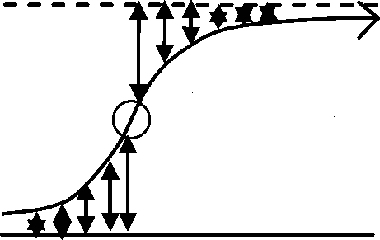 When diminishing returns occur
for an economy as a whole its seen as meeting natural resistance, in steeper
learning curves, shortages causing higher prices and erupting internal and
external conflicts, throughout the whole system at once. Nature is
sending the same signal
for the system as a whole that peak development in an individual business
indicates, that increasing investment is decreasingly productive.
It then decreases the productivity of investment to continue multiplying
investment, heading toward a point of whole system climax where the
productivity of investment comes to zero. It could not get there, of
course, since zero return financial systems would not be stable.
When diminishing returns occur
for an economy as a whole its seen as meeting natural resistance, in steeper
learning curves, shortages causing higher prices and erupting internal and
external conflicts, throughout the whole system at once. Nature is
sending the same signal
for the system as a whole that peak development in an individual business
indicates, that increasing investment is decreasingly productive.
It then decreases the productivity of investment to continue multiplying
investment, heading toward a point of whole system climax where the
productivity of investment comes to zero. It could not get there, of
course, since zero return financial systems would not be stable.
To maximize the natural capital and its positive rate of returns would then
result from investment returns being diverted and freely spent on
non-investment interests, treating the economy as a whole as a "cash cow".
Stabilizing that way leaves an ample pool of
investment to maintain or update outmoded parts of the economy, while
maximizing rates of return and dispersing wealth to extend prosperity
throughout the whole system. As for a single business,
it's just responding to the environmental signal in the way providing the best
total return.
Why that strategy does work
for natural systems and does not work for people is that people continue
multiplying their own investments as the whole system runs into resistance.
The resulting zero sum game at the end of growth then becomes an accumulation
of conflicts more than an accumulation of wealth. The technical
solution J M Keynes called "the widow's cruse" is for those with surplus funds
to spend them as they would with the proceeds of a cash cow business.
How to organize it is less clear, but the requirement is quite clear.
It would also have the unusual effect of decentralizing wealth as part of the
whole system response to approaching sustainable climax.
What
you see now is the opposite in terms of our "natural capital". As the net
productivity of investment in the earth (new wealth minus new impacts)
decreases, the concentration of wealth has been increasing too.
That is the opposite effect of making the opposite response. Ending
growth by maximizing total returns then, creates an economy that is stable,
vibrant and changing, at the beginning of a long a productive life of
stability, just not exploding. When you look at
successful organisms throughout nature they all make that same discovery, that
the turning point from growth toward stability is the beginning, not the end of
'the good life'.
There are a great many 'relief valves' for
the forces and pressures in our economic
 system, and it once
had a marvelous stability. Our great wealth comes from the
interaction of a lot of talented people trying to make things work, connecting
with each other through free open markets. There are dangers,
though, in pushing it too far. Relying on ever more complex ways to
accelerate the use of diminishing resources, robbing them from people who can't
keep up and otherwise pushing everyone's interests into conflict, creates
instability that is irreversible except by collapse. Expectations
for growing financial returns from diminishing physical returns are guaranteed
to be disappointed. You get cascading failures of expectation.
system, and it once
had a marvelous stability. Our great wealth comes from the
interaction of a lot of talented people trying to make things work, connecting
with each other through free open markets. There are dangers,
though, in pushing it too far. Relying on ever more complex ways to
accelerate the use of diminishing resources, robbing them from people who can't
keep up and otherwise pushing everyone's interests into conflict, creates
instability that is irreversible except by collapse. Expectations
for growing financial returns from diminishing physical returns are guaranteed
to be disappointed. You get cascading failures of expectation.
Just following "productivity growth" to it's logical
end amounts to making ever bigger decisions about the future ever faster,
leading to a certainty of making ever bigger and longer lasting mistakes.
You can see them growing all around us, like global warming. The
hurried 'solutions' contain many of the same mistakes too, like offering
'alternative' resources to only find them just used to continually leverage all
others, repeating the same 'fault' being blamed on fossil fuels.
Why people don't openly wonder if we're making some mistake, given nearly
everyone's good will and the dramatic evidence we're making the problem worse
is a puzzle. It's clearly that multiplying our solutions is multiplying
our problems, though, once you ask.
It is in the nature of exponential growth
to bring about the unforeseen, of ever larger scale,
 at an ever faster pace.
Growth for us has been very rewarding for around 600 hundred years.
Slow accumulation, using success to build on success over the long haul, has
produced a very dramatic change in the promise of human
history. Past performance, as they say, is no guarantee of
future returns though. That's especially the case in humanity's
clear diminishing net returns on investing in the earth. The
benefit/cost ratio is simply not what it was.
In order for the economy to climax the amount of investment needs to
climax. That's possible either at a healthy high level or after collapsing and returning human culture to a new era
of feudalism. It only depends on how persistent we are at
compounding our errors.
at an ever faster pace.
Growth for us has been very rewarding for around 600 hundred years.
Slow accumulation, using success to build on success over the long haul, has
produced a very dramatic change in the promise of human
history. Past performance, as they say, is no guarantee of
future returns though. That's especially the case in humanity's
clear diminishing net returns on investing in the earth. The
benefit/cost ratio is simply not what it was.
In order for the economy to climax the amount of investment needs to
climax. That's possible either at a healthy high level or after collapsing and returning human culture to a new era
of feudalism. It only depends on how persistent we are at
compounding our errors.
There are a variety of other
possibilities, but those two are the achievable extremes. There
are also other issues we need to think all the way through, like population and
entitlements, all the bad habits of being a successful small organism with
apparently unlimited resources. The financial system correction would
have investors
'spend' their 'unearned income' so that their investments didn't
multiply, relying on savings from earned income to maintain the investment
pool. It would be come self-reinforcing as investors recognized anyone
who 'cheated' to get ahead of them as a cheater. You could call it
a change in the "prudent man rule".
Some
significant community of investors would only need to change their own
personal habits that way, and object to doing business with others who didn't. --
A basic model of money flow that describes the choices for financial growth on
a finite planet is discussed in General Allocation Theory.
An further description of the dimensions of the problem and solution are in
The One real option..
natural climax
and the science of natural economies as learning systems
Hidden Life. 6/23/06 9/10/06 08/26/08
Microclimates
Air Current Networks.
The origin of my
work on scientific methods and natural systems of change was a careful study of
evolving air current patterns in buildings, originally begun as a research in
building climate and architectural design. It led to discovering a large
number of unusual undocumented air current structures and patterns, and the
simple observation that air flow is an amazing designer of new forms in profuse
variety with clearly no directing formulas involved, all in the complete
absence of 'noise' and entirely out of control. Natural air
currents in confined spaces are constantly evolving complex history-dependent
structures beginning with growth, "with nothing there but molecules".
Invention.
One of the unusual
air current structures observed has the effect of eliminating turbulence near a
surface where turbulence would otherwise normally develop, potentially
improving the efficiency of heat exchangers. The portion of a working
fluid having made contact with the heat transfer surface can be extracted
without allowing it to mix with the unheated portions. Some
of my work on patents using this trick is available. If you're at
all interested you should speak with me and possibly use me as a consultant, to
make sure you understand the particulars necessary for making it work.
Current Writing and Research Issues
~10/2011
Our modern culture developed
was with following rules for a small scale economy to grow as fast as it
could, in a very big world. Our rules haven't changed but our
world has. Today we're
seeing the world's resource markets responding as a group, unable to
recover from more frequent and larger supply shocks, and permanently increasing the floor level price
of natural resources. It's a sign that the markets searching
the world for more stuff are learning that nature is running out of
expanding supplies.
A good introduction to that is my article,
A defining moment for investing in Sustainability, in New
European Economy. It's also important to have a simple
way to understand the deep problem, in a nut shell,
Why
it's natural to find reality confusing?
What's going right?
People are slowly, but
very slowly, noticing that "sustainability" is more than
convincing people to live morally and efficiently. We also
need to correct some accounting errors caused by economists,
following the lead of physics, describing the world without its
active learning parts... So it's the hidden
impacts of how we use money not the easily checked and recorded ones
that we've been omitting from our plan. Not
surprisingly, that's the great majority. It does also mean
that some policies to reduce visible impacts do so my
increased the hidden ones, and it will take a culture change to
correct that. You start by discovering the evidence together
to learn from.
System Energy Assessment (SEA)
The 30 years of work
on
exploring the lack of connection between how the natural world
works by itself, and
the models human thinking makes up for itself to represent it
continues. "Physics principles for naturalists" is one way to put it, a way
to keep your thinking straight and connected to its complex
environmental system subjects. What seems to be an actually
10,000 year or longer addiction to use improving productivity
to solve all problems seems to have made us more productive than our
planet can sustain, so our ignorance of that allows a large variety
of critical moral issues to go unquestioned.
(2011) "Nurturing
cash cows or crash cows?" and
"simple
facts... and hard memes"
*Reading Nature's Signals is my blog, see
the sidebar for collections of posts on different topics.
Odd
Notes - most of what I write starts with scattered scraps
of paper, and there's a pile...
I'd like to find some web tool that could allow random browsing and record
comments on a collection of separate notes ..
- 8/08/10
The fact that you can't know something unless you want
to is good cover for those who don't want to, and little deceptions grow
into big ones in a culture organized around endless growth.
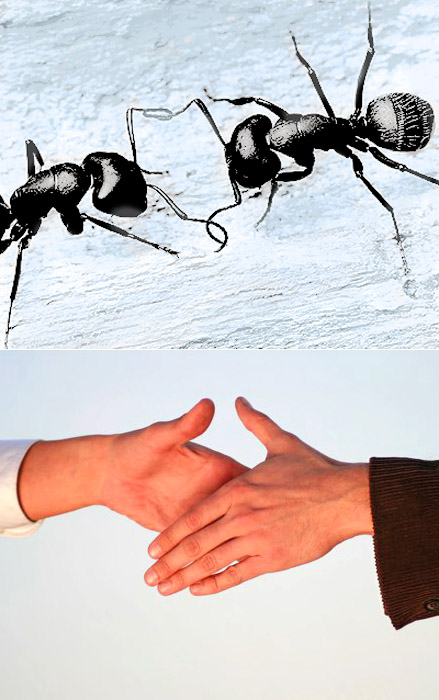 -7/6/10
Ants seem to rub antenna just the way people shake hands, i.e. quite
expertly and without thinking about it, for mutual recognition of complex
relationships... Wow! Those simplest of gestures
between animate beings, mutual homing of independent systems, a smile, a
kiss, responsiveness without analysis, a dance with a partner experienced as
becoming one. I don't think it'll ever quite make rational
sense, or be possible to program for inanimate beings. Is there
a difference between a "squeeze" and a "hug" ? Yes, most
definitely.
-7/6/10
Ants seem to rub antenna just the way people shake hands, i.e. quite
expertly and without thinking about it, for mutual recognition of complex
relationships... Wow! Those simplest of gestures
between animate beings, mutual homing of independent systems, a smile, a
kiss, responsiveness without analysis, a dance with a partner experienced as
becoming one. I don't think it'll ever quite make rational
sense, or be possible to program for inanimate beings. Is there
a difference between a "squeeze" and a "hug" ? Yes, most
definitely.
- 4/29/10
There's
something odd... about God apparently not having studied ecology, when
telling his most capable creature to work like a slave to control ever more
of its environment, not realizing he had made nature thrive by things taking care of themselves
and staying out of each other's way. Equally odd is that we
believed that story of a world with no individual parts.
- 2/16/10 You can't inflate a pile of dust. You can't get a perfect image of a
person to talk. Information and things have different dimensionality
in a much more stubborn way than information can express, despite the ease
with which our conscious minds refer to themselves as the real thing.
- 2/16/10 Just because you're underwater doesn't make you a fish. Men got
a little carried away with carrying the water, always filling the tub, now
burst, with everything along with the water carriers now deep under water.
Need something new to do. It happens.
- 2/16/10 So where did the thong that the first weapons were made with come from,
tying the stone tool to the wood shaft? Was it from the woman's amulet
around her neck everyone so long admired, or the way she tied her hair?
Or did it come from the sling discovered one day when both ends of a piece
of gut were tied to the kill and it freed the hands to put it over the
shoulder? Those original "string theories" probably all came at
once, the way technology radiates, along with knotting and weaving.
The Venus figurines mostly seem garbed in fancy threads... Were those
the first killer app's of technology, 20k, 100k or 200k years ago?
- 2/16/10 Statistics generally come long after the fact, accumulating many beginnings
and endings and he silence of being over and done. Leading
statistics come in many styles but the highest confidence one with potential
to let you join in or nip off what's happening is emerging continuity of
proportional change.
Some things to fix?:
-
What if we read
the meaning of "fiduciary duty" as written? It's unqualified, and
where it matters would hold those accountable to the interests of others and
not support misleading acts or speech? One might argue that an
obligation to not be misleading defines a more truthful measure of "the
whole truth" than is actually used in court. Maybe it could be
used there too...
-
What if all software
came with a command line window.... where typing a command name runs it and
adding a "?" explains it's normal uses and where to find it on the menus?
-
What if politicians tried to impress people with
better information about their world rather than promises they can't fulfill?
-
What if online adds a narrow check box bar at
the bottom, with one click for
Truthful? Y, N Helpful Y, N?
-
What if Google let you choose what bias to use,
the Kids view, the Women's view, the Scientist's view, your Tailored view... a Neutral
view...??
Concept &
Comment:
.....little essays
(see my blog
for some comments, posts & letters worth recording, and
article & forum list)
-
Why finance has a bigger appetite than
the earth - 11/10 a simpler version with a good definition of 'natural
capital'
-
Vicious spirals & their
relief –
3/09 food for thought about solutions
that multiply problems
-
What wandering minds need to know -
3/09 our strange drifting realities and how to reconnect
-
Response to Haiti
- 2/09 the lasting effect of helping people the right or wrong way - issues for
right now.
-
Throwing our
energy at impossible dreams..
- 12/15/09 Our unexpected arrival on a
rather changed planet

-
Peak Zucchini
- 11/20/09 The story of overabundance and when
to give it away for our Thanksgiving...
-
What
in the world is really going on here? -
11/15/09 How our work
ethic accidentally pushes us up an ever steeper learning curve
-
How we get out of this -
11/11/09 What to do
when it's your solutions that become the main cause of your problems
-
Inside Efficiency -
11/10/09 The mystery of why
doing tasks ever more efficiently multiplies their services and impact
growth
-
The Missing Variables in Thermodynamics -
10/24/09 The unhidden
but missing energy that builds energy flow systems

-
Lines of Sustainability -
research
notes on defining the limits of sustainability and points of vanishing returns.
-
Economies That Become Part of Nature -
how we can, why we have to

-
When = becomes a sign of change -
The real "millennium bug" is all the = signs
becoming ? marks.

-
Nature's
Table - A sketch the economy as a natural system
5/30/09
-
Efficiency Mistake -
the main unwanted reverse effects of efficiency & productivity
5/27/09
-
Crossing the Line of Sustainability -
The next bigger issue
after climate change, when healthy systems collapse 05/21/09
-
Concept$
-
Physics... pointing to a clear way out 3/20/09
-
Reset$ -Halt the
spiral with an executive order ... reset debts to their true
value... It's the money game that is bankrupt. Resetting the game by
declaring "game-ruptcy" would quickly rebalance the system, relieve it of excess
burdens, be much easier, fairer and of lasting value for redirecting our efforts
to becoming sustainable in the long term. 2/21/09
-
Einstein,
Keynes, Boulding & Jane Jacobs ...
the ancient
struggle of human information and belief with physical reality:
the view from our collapsing tower of Babel looking back to the time and place
of the first one. 2/20/09
[i.e. looking back to that important milestone in mankind’s emerging battle with
the hazards of superstition and magical thinking]
-
Spying Black Swans -
A
simple statement of the problem, some notes 2/6/09
-
Words End
- Naming our metaphors & connecting them to what's real...
12/17/08
-
Ponzi
Rules! - How guaranteed investment returns all become Ponzi
schemes 12/16/08
-
Profiting from
Scarcity - (our compounding investments in the depletion of
necessities) - draft for the
OilDrum
-
Reading the
Limits - (sweet & plentiful to scarce & sour) -
draft for the
OilDrum
-
The One real option..
natural climax -
Updating JM Keynes model of sustainable capital for
economies
-
The upside of blind
spots... Clear Spots - Talking Points - Specific kinds of
fixations and the life they hide 5/14/08
-
Hidden Life -
Life’s Hidden Resources for Learning
5/14/08
-
Models v. Manuals-
Why scientific models don't make good operating manuals - missing nature's
working parts 5/14/08
-
Corn & Milk - The price collision
between alternative fuels and food 4/12.08
-
Retargeting
Sustainability for Full Effect -
Talking Points - for two large conceptual errors and hints at
a whole solution.
-
World GDP, Energy, distant Past & Future -
The best data on world energy history past and
future..3000 yr! 1/18/08
-
World
Energy & Efficiency
- Detailed 40 yr Energy & Economic Efficiency data
-
Key
Principles of Natural Systems -
list of simple useful concepts for "what's happening"
12/07
-
Natural Limits of
Efficiency - draft research note on how to apply basic physics to evolving complex systems
12/07
-
Climate Lags -
The long view of a changing
earth - to which we'll need to adapt 9/07
-
The one real option -
Natural Climax - The natural systems
approach, first explored by Keynes 5/08
+ed/s
-
Natural Climax
Model
-
Transformative self-control
- leaving us free to adapt 8/07
-
Sustainability in the Times -
One of my
favorite tiny studies, tracing the formation of an idea 10/06
-
Our Little Unexpected Pregnancy.... an
approaching change of life
8/07
an
approaching change of life
8/07
-
PICS
of a general model for exploring complex systems
07/07
-
$1=10,000 sf sunshine-hours
basics of
your economic energy shadow 7/07
-
How to Think
the first step many never
take 06/07
-
Reading Growth
for emerging complex
networks,
NetSci conf.
handout 05/23/07
-
Why Sustainable Design is Unsustainable
and a great reason to change our way of thinking
4/07
-
Why it Doubles Energy
Consumption to double energy efficiency
3 meg
[get
PPT viewer]
-
Required Steps to Sustainability
that remain largely unthinkable
-
To Explain the way I think
SOME explanation might help!
11/20/06 3/15/07
-
The Emergence of Sustainability
exploring emergent system events through
word use. 10/28/06
-
The
Feedback Switch reversing central system feedbacks has large
positive effects 9/9/06
10/14/06
-
Splitting Parts
are not Homeostasis -
7/02/06
-
Getting up to Speed for
Cooling it Down the world is moving fast and we're not -
6/15/06
-
Phil's
state of the planet 06 an amazing conference on saving the earth,
and an amazing gap in the plan - 4/05/06
-
Why we're all
mostly out of the loop a structural reason to miss what's happening
all around you
-
Large
Change / Small Window Power Point on the growth crisis and the
basics of natural systems - 2/05/06 [get
PPT viewer]
-
Whole
new ways of thinking while we weren't looking the world
changed... 8/14/05
Odd Facts
- 8/10 The one practical way to stop adding our burden
on the earth is to stop adding the profits from it to the principle for
expanding our investments in it, as you do with any successful project to
end its expanding on itself to its role in the world as you complete it.
- 02/10
The true energy source of the future is
learning to get along with nature, as learning the system has always been
the real source of energy.
- 06/09
How nature
builds things is generally illogical because building up physical system connections
uses complementary parts that link through their differences, unlike how logic
connects through equalities. As
for building a house, neither foundation or roof
look at all like a place to live, though they're start and end to making one.
- 06/09
What we perceive is a
simple culturally reinterpreted mental image of physical things being looked at
of quite different kinds and much greater complexity, explorable but not fully
comprehendible in any part.
- 06/09
Models that imply
approaching instability mark systems that won't continue, and times when new
form will emerge.
- 06/09 Being constructive a
matter of logic, but using complementary things that make different sense to
link into wholes. Foundations can't be lived in and look NOTHING
like a house, nor does a roof or even walls really, but a house without them is
unlivable.
- 02/09
A
telescope may not look much like a universe...{but lets you see one)
- 10/08
Environmental systems don't follow the past
but diverge from the present, on continuous branching paths of accumulative
change
(making ways to watch where they're
going and see the complications they're running into)
- 7/08 If
you find yourself having to fix ever bigger problems, you're fixing the wrong
problem... (and the real solutions maybe just look ridiculous)
- 5/08 A
main issue now is how the parts of growth systems as they run into natural
limits all run into each other, in conflict - 2/08
All kinds of
natural systems are little worlds, having internal design and behavior of their
own
- 7/08 "The
media" refers to form of conversation that seeks the "passionate assertion of
the opposing point of view" for entertainment, not any form of successive
exploration and validation of anything.
- 2/08
If
you see as pattern of continuous divergence, there's a little multiplier
inside.. and then you need to
decide if you should try to: a) turn it off, b) get out of it's way, or c)
let it go to it's own level of comfort to become a partner in your world.
- 2/08
Absorbing CO2 produced by average spending w/ trees,
add ~1acre
of mature forest per
$150,000
- 12/10

Some philosophy in a phrase:
7/14/06... 12/09/10
... It doesn't need to spoil the music to
know it's just vibrations on a string.
... To enjoy the trip and avoid the
trees, watch your path, not your past.
... The
Lion sleeps a lot and the eagle soars, but this other top predator on
earth is so busy busy busy.
... When it's appropriate to say "Oops",
putting off the face saving might be a lot more
planet saving!
... It's that
the circle remains open
that there is any place to connect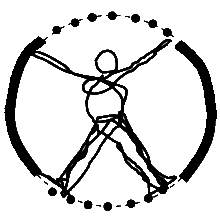
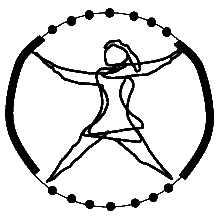
... Discovering things that
just can't make sense
prove you both must be
... What knowledge seems to be
good for is reaching for reality,
not being reality
... What actually matters is
the gracefully possible
... the "gold" rule: Trusting
that gold can forever multiply is a
perfectly fatal rule.
... Life benefits from the Zen art of
finding you always have the right tool
already in hand
... If you don't look up,
you won't see the horizon,
nor hear of the path that leads to and beyond
... It's not the truth that sets you free,
it's the true questions
that take you there
...
it's not finding what people say interesting, but
finding what's interesting
in what they say
... again, the
truer model is the one you look through,
not the one you look at!
... every good idea seems to need a little fixing
... When multiplying things
until there's trouble,
it's not what we're paying attention to that misbehaves!
... the problem with
deciding who's right is that everyone is, from a different point of view
... one
reward for facing hard
truths is finding a place for your deep values
... things that absolutely can't be avoided must be on your
path, and good for SOMETHING !
... government doesn't
cause interference.
It’s interference that causes government.
It simplifies government to face approaching
realities, and complicates everything to chase them after they're gone.
... finding what science has been missing makes the Earth
boundless, unexplored and mysterious again.
... a funny thing about how science has studied 'emergence',
searching for the rules for what does not follow
them, and ignoring the individual processes by which
it develops.
... Faith is having
permission to go do it your self
... "Free Will" is a simple gift, the necessity of choosing
to engage in exploring to find new choices
... If you choose to hate your
enemies and not learn from them, you've lost the battle.
... I whisper
in the ear of God day after day, hoping he gets the
message
Personal
Bio - Jessie Henshaw
Jessie Henshaw is a not so retired 63 year old woman,
who went back to full time work on her science when it became possible, living
in New York and writing as "Mother Nature" in her journal online research
journal Reading Nature's Signals and as
Shoudaknown on Twitter. "P. F. Henshaw"
is pen name used on some published papers.
- 03/08 8/10
11/10 4/12/11 7/4 9/7/11
Every way to
tell the real story gives a narrative that leaves things out, and that's one way to tell it's real.
It's a reader pausing to wonder about
those gaps that directs their attention to the larger world of unmentioned
things that made up the reality for its subject, and makes the telling
about a real life rather than the characterizations either the teller or reader
might use to fix their own images of things.
This nice old sketch
is from the late 70's, when I was doing my early experiments and study of how
uncontrolled natural systems work. I've changed since then,
both inside and out, needing to more or less start over with my life and
relationships about again and again. I still share the same
sensibilities I shared with my earliest friends, but kept finding them not
fitting in.
My
start..........
ed. May 2000
I
was born in December 1946 and grew up in
Hamilton
NY, a small college town (then 1300 in the village and
college each) in hilly central
New York dairy farming country,
Chenango county. My dad was the head of the Colgate physics
department. At the family dinner table physics wasn't considered
a fit topic of conversation, particularly at Sunday dinners. Dinners
were family time. My mom ran the household, often made her own and my
sister's clothing, and the whole family pitched in on the garden.
My sister, brother and I, as well as my
mom and dad, regularly had three meals a day together at the family table.
At lunch my dad walked down the hill from the college as my sister, brother and
I walking home from school, and had a simple meal together. The
family followed an easy going version of the classic "American chore machine"
model, having regular daily and seasonal chores.
We regularly went to
church, mostly to participate in the community, and have various other community activities.
It still left the kids plenty of time to go out and find things to do with
neighborhood friends.
My
dad and I also spent endless hours talking about what you could observe in
natural phenomena of all kinds, in the garden, looking out the window or walking
around, exploring how the world worked. We also did various projects
up in his physics lab
or in our workshop in the basement at home.
He was quite a skillful teacher and taught me a lot of physics without any
math when I was little, just showing me how to observe explanatory principles in
natural events. That seems to be where I first caught an interest in how
nature and our explanations for things as being different things, and each prone
to change by themselves in different ways.
For
a kid with freedom the big event of course was being 'out', roaming the
village and surroundings with neighborhood friends, getting together on our
bikes for games at different playing fields, gathering at the great swimming holes, using each
other's back yards as familiar battle grounds for long standing pea shooter wars
and games of 'capture the flag' that would go on until we were dodging the bats
in near pitch darkness. We also roamed the local fields and
hills, building both tree forts and woods encampments, spending a lot of time around the
creek that ran behind our house.
I think my favorite place of all time was the
clump of big old willow trees along the creek called Fallen Timbers.
That's where the
great old trunks had leaned over on each other to form various bunkers, ladders and
bridges like in a real jungle, with which my friends and I could play Robin Hood or Peter Pan.
Our
property had a big lawn and my mom kept a number of flower gardens, and we had
big vegetable gardens too, maybe 50x25. We also had wild areas out back
bordering the fields and stream, a small section of woods, a bog, meadow and
some wild rose and other brambles. It became my extraordinary privilege to
become the wild gardener of them for a few decades, up until my mom stopped
being able to care for the house and we gave up the property to a local doctor
and his young children, in about 1996. In a way that wild area
behind our house was my home, almost like a miniature version of where I now
live, with Ft Tryon Park in Manhattan, down the street from my apartment
today. There I find much the same kind of enjoyment of a mingling of
carefully tended and rather wild nature.
For
college I went to St. Lawrence university in northern New York, which had a good
physics department and let me play football, and spend weekends in the art
studio. I thought to do graduate work in math or physics,
and did some post-graduate work in
mathematics at Stony Brook and then
Columbia, but somehow the questions
were starting to seem uninteresting. After college I shared an apartment
in Brooklyn with friends with my bedroom like an art studio, painting a lot.
I ended up experimenting with a night school course in architecture, and found
it curiously like physics in having a serious interest in 'form' as being
central to design, and went to the Univ. of Pa in Architecture in 1971.
In
the 70's, after graduating from Penn, stimulated by a wonderful upbringing
and education as well as daring new ways of thinking from the 60's, I traveled
and ended up in Denver, deciding to learn to be a builder as my "post-doc"
project for becoming an architect. In-between things I took a
graduation gift and assembled a portable micro-climate lab, and traveled around
Colorado and New Mexico studying how the indoor climates of both conventional
and solar houses worked. Practically the first day out I began to discover
all kinds undocumented natural phenomena, different kinds of "organized
molecular motion" that I had never heard of and was unable to see how they'd
work. Physicists just don't tend to study the world as a naturalist does,
just going to look to see what's there.
It
lead me to discovering a set a beautiful explanatory principles for the design
process of nature's animated systems, that has been my work since. It's
been my work, that is, except for somehow making a living, which I often had
trouble doing. What I found was disturbing. The simple
principles of natural system design assume that nature's systems work by
themselves, and our society's understanding of physical world is that everything
is controlled by something else, a totally different idea. What I
found seemed to confirm and reinforce many my culture's sensibilities, while
deeply conflicting with its explanations.
So... it confused everyone I tried to explain it to. So as I got
established enough with a new group of researchers or activists to start showing
the details of what I found I would lose their interest and respect, having what
seemed like my whole life fall apart again and again. Still, there is
something deeply wrong with traditional explanations, and because I seemed to be
pointing right to it, and having any fun was having a great deal of fun, I kept
pulling thing back together and trying a new tack.
After Denver fell apart I managed to recuperate at home and then get back to New
York, and overcome the dent in my resume of taking 10 years after grad school to
get my first job in architecture. I worked in offices all over the
city, and in the 90's and 0's actually did do some arguably fine work.
I was married from 1986 to 1994, and my son Jonathan is now 23 and out of college. It
once seemed my relationship with him was my easiest duty and greatest pleasure, giving him as much as I
could of the enormous freedom and fascination
with the world around us that had been my privilege to enjoy.
But things happen, that you don't understand.
Learning Experiences
 11/2010 7/2011
A human mind can be a dangerous thing, for
how it presents what the world as a reflection of ourselves. It
causes us to perceive that everyone else in the world happens to live in the
world of our own imagining. When people don't know to or can't check to
discover how each other's minds construct the world differently, we can expect
other people, or even the natural world, to know things about us and their roles
in our lives that they just don't. That's one a hundred insights in
to the complex nature of perception and behavior that came out of probably my
most fruitful intellectual relationship.
11/2010 7/2011
A human mind can be a dangerous thing, for
how it presents what the world as a reflection of ourselves. It
causes us to perceive that everyone else in the world happens to live in the
world of our own imagining. When people don't know to or can't check to
discover how each other's minds construct the world differently, we can expect
other people, or even the natural world, to know things about us and their roles
in our lives that they just don't. That's one a hundred insights in
to the complex nature of perception and behavior that came out of probably my
most fruitful intellectual relationship.
That
relationship was my extended conversation with my high school friend John
Blackmore, who lived five doors down the block, and who had wide interests in
psychology, philosophy, and the general scope of life. He became a social
scientist and policy analyst on criminology, who continued to bring me many
connections between those perspectives about the social and perceptual phenomena
I also explored from my physical systems view. We shared an apartment in
Brooklyn and a community of friends developed from there that grew still
surround him when he passed away from a long illness recently.
Architecture
school strenuously pushed my imagination, and I found I had the very good
fortune of being there the last two years of Lou Kahn's life. He was a
true source of widening vision, the way he would always see the world as
undiscovered. Many of his inspiring messages stuck with me, like the
need to search for the form of each design in "reading book zero". I also
had a remarkable experience of studying dance with a Guerdjieff inspired
improvisational dance group, called "Group Motion".
Those combined with the powerful effect of being, immersed in a creative
community for the first time, after only being surrounded by sciences all my
life, was tremendously energizing. It left me inspired by the
open world that school is supposed to show you, and by the end of school, truly
ready to begin.
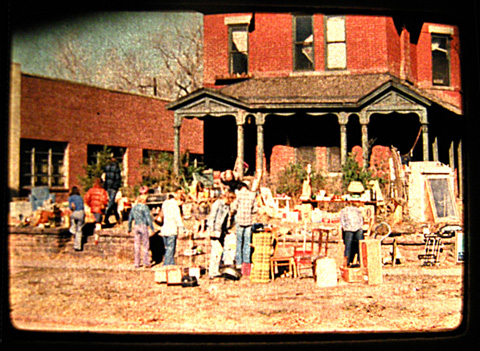
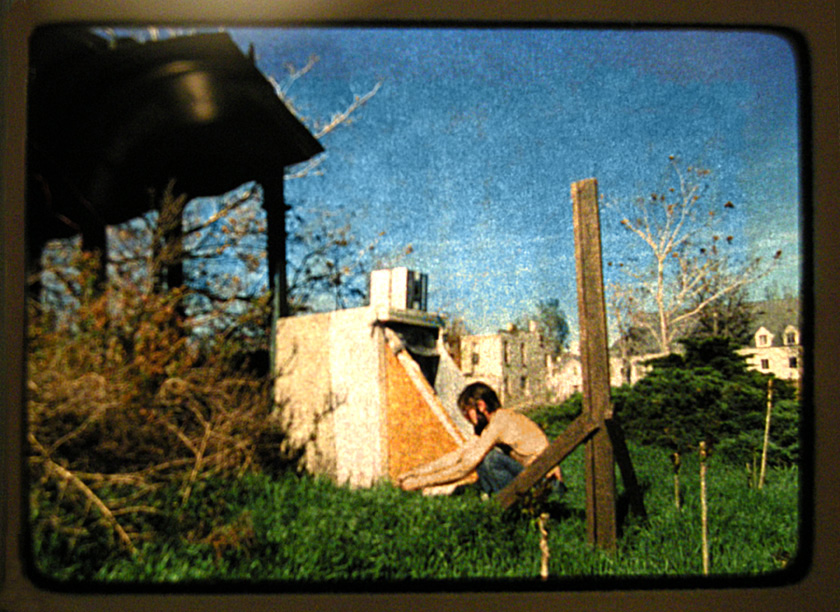
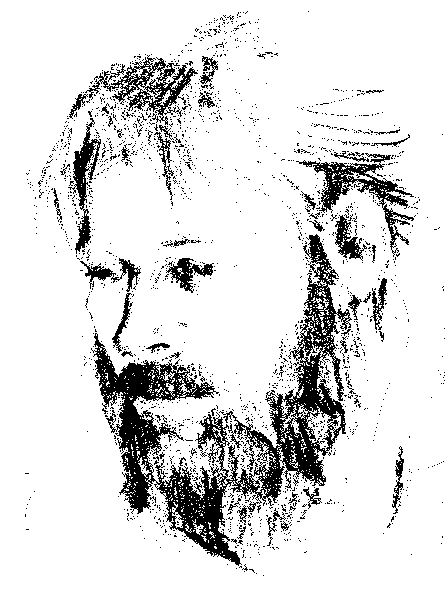
The sketch
above is by Terri A
Storer, done in 1976, from my
Denver 'heydays'. She was one
of my four women who were important spiritual guides for me in the 60';s and
70's, and each changed who I was. I really could not have
gotten anywhere at all without them. Johnny, Gerry and Chantal
were the others. When Terri did the sketch I we were living in a big
old
"tumbledown" house,
rented with a group of friends for $100 a month, and had all
my strange solar experiments on the
lawn. In Denver I found connections to the west coast and Oregon
"appropriate technology" community, the precursor to what later became known as
sustainable design.
I
took my research and writings around to conferences and wrote some for RAIN
magazine, edited by Tom Bender a visionary and graduate of Penn architecture.
That whole vision of how to save the planet, also inspiringly conveyed by
brilliant thinking of Bucky Fuller, in the end turned out to be what I started
finding deep flaws in and was a repeated cause of my being socially and
professionally ostracized in years later.
One
of my other sources of vision about natural
form would seem to have been Kenneth
Boulding, the economist.. He was my dad's best friend when they were junior
professors together. I say "would seem to have been" because we
hardly talked, but I followed in his footsteps somehow. I didn't
even really know what his work
was when I saw him come and go at the house or heard stories about him,
because he made a splash wherever he went. I didn't know what a visionary
man he was, not until the 1980's when I began writing research papers for the
General Systems research society he co-founded.
I
must have picked up his questions "over the transom" somehow, because my dad and
I never discussed systems theory and I never studied it, until after I wrote my
own general theory of natural systems, just by piecing together all my own
observations in 1979, and finding my questions so relevant when I discovered the
organization he led a few years later. Ken also was the one to point
me to J.M. Keynes, and the cler evidence that Keynes was a systems ecologist
with far reaching insights well beyond what his work has been taken for.
While I've published various
papers over the years, my main work as
been exploratory research on methods of identifying independently organized
natural learning systems and discovering their surprises. It's been
a large technical task involving new math and software design, and being unable
to share them with others and leading to the failure of my best and most
complete efforts in about 2001. I think after 10 submittals, of
the plankton paper, I failed to find a single
reviewer to even respond to the very clear question being raised, the clear evidence of
evolutionary change following growth curves, indicating an additional mode of
evolution. After that I stopped every effort in disillusionment, as
I had with other broad failures with other communities in 1980, 88 and 96 and
2002. In 2004
is started thinking I could just do it for fun, and not for any real purpose,
and that would be OK. I slowly started writing down some notes again.
In
2005 the sustainability movement emerged as a social force and I
recognized the signs of the approaching economic failure, following the expected
pattern of changes of a new scale and kind, that would exceed our ability to
respond. I started buying books, lots of them, and expanding
my correspondence, searching for any hint of others having found the thread of
insight into natural systems, and the series of questions that helps you
discover how they inventing new rules to follow for themselves. Everyone
just had their own theory for them though, about how nature works following
their rules, in effect. It built up to another disaster.
Still, starting to intentionally steal other people's questions greatly expanded
my thinking and ability to discuss things from multiple points of view. I
also reconnected with Stan Salthe, who had presented papers at the same meeting
of SGSR in 85, and been my hotel roommate, and we proceeded to have a wonderful
long correspondence.
So having fun putting pieces of different people's ideas together, buying lots
used books online and going to conferences on hopeful solutions, helped
me invent lots of language experiments for discussing it. Still, I
found it exceedingly difficult, and painful, to perceive the mounting unmanageable dimensions of it.
No one was interested in understanding the basic requirement for relieving the
demand for growth at the limits of growth, along the lines Keynes' proposals had
confirmed. My learning was succeeding in the sense of being very personally satisfying, broader and more complete,
but I was still quite unable to
find an approach anyone would respond to or see how to put anything on paper again.
It took I think three years of only being able to write "odd notes" on loose
scraps of paper before I could get back to finding subjects I could see how to
write anything longer about.
The
intellectual start came out of the seeds of thinking Stan helped push me to,
discovering the theme of systems being steered by the learning of their parts.
It actually came from reading "The Pond as a Microcosm", the seminal paper of my
great grandfather's, Stephen A. Forbes, the very early ecologist.
That resulted eventually in my papers for Cosmos and History that Stan
encouraged. The rest of the world wanted things served up only in their own
language following their own assumptions, so I was still mostly at a loss, and
desperately looking for what everyone's common language could possibly be,...
Everyone's expanding interest in sustainability seemed like it might not lead to
whole community rejection of my work again, but it fairly directly did. As
usual, it was as soon as people began to understand what I was talking about,
and see the implications of learning to trust what nature is visibly doing over
one's preferred theory, for telling you how nature works.
2008 to present
 Jul 2011 From the view of June 2008
when I was 61, I had made these basic discoveries 30 years before, and they
still remained problematic for sharing with others. It seemed to be
What happened to wreck my life. That description needs updating,
but I was in deep pain from finding my
rather wonderful discoveries to be antithetical to the whole culture
around me. My experience was confusion about why my whole world would seem to prefer
to be quite dishonest with itself, clinging to
its flawed cultural beliefs when they so clearly differed with fairly simple
observation.
Jul 2011 From the view of June 2008
when I was 61, I had made these basic discoveries 30 years before, and they
still remained problematic for sharing with others. It seemed to be
What happened to wreck my life. That description needs updating,
but I was in deep pain from finding my
rather wonderful discoveries to be antithetical to the whole culture
around me. My experience was confusion about why my whole world would seem to prefer
to be quite dishonest with itself, clinging to
its flawed cultural beliefs when they so clearly differed with fairly simple
observation.
I don't blame
people for being themselves, or for having grown up within the same culture and
its mistaken beliefs that I used to trust too. It still did feel like a real breach of
personal trust to have the people all around me not respond, as if it was my
mistake to discover a need to overcome our society's false thinking. There
became no way I could "have a life" being
treated as if I was actively opposing everyone I worked with and cared about at every step.
So I just became desperate to escape. Having spent a lifetime
studying how nature changes form, and my being desperate to discard an old one.
I just let my revulsion for the circumstance tear my emotions from it and, quite
without a plan started grasping at threads, for whatever offered comfort and
delight. I found it as those threads led me to what had previously been a
very hidden world for me, becoming a woman, and then a wonderful sense of
relief.
Becoming a woman from the inside is a bit different from taking on appearances, but how would an observer know? You might not, but it
gives me a real life, put together piece by piece, that I tremendously enjoy and lets me continue to carefully
study the world around me. It also lets me enjoy people simply as people,
without prejudice or feeling that I'm obligated by the beliefs of the
wider culture, or need to conform to things I know are mistaken. It seems to be a true escape for me,
that both gives me a rich life and freedom from the oppressive experience I'd
been having.
This
was the fifth time I had found my life falling apart for much the same reason, causing the people I tried to communicate with
to burn bridges and avoid me instead. People clearly heard what I said,
though, and heard it as being
clear headed and sensible, but also that it didn't fit their cultural
expectation. One of these deep issues is our cultural faith in being more productive
for creating resources
to replace depleting ones. That's the long popular idea of sustainable
development. In so many ways it's very clear that productivity only accelerates depletion
of all our resources, ...is the problem.
I
was finding that our culture lacked
the mental tools, the perspective, to
even have an interest in that kind of insight. To notice the errors in
one's imaginary world requires curiosity about how to stretch your ideas to fit
nature, and be alert to where they differ. All I was getting back from
others when I pointed things like that out was
the opposite. They tried finding creative excuses for the faulty
reasoning exposed till they found one that worked, seeming to only remember the
intrusion of my having mentioned them. It was very traumatic to clearly
see that pattern being repeated over and over.
At
that time the economy had begun racing toward its financial collapse
that would occur in the fall. I was seemingly at the peak of
my career as an architect, having completed the detailing and coordination
for a U.S. Federal Courthouse building. But I was also running into
conflict with employers, one after another, whose deals seemed interfered with
by my apply my skills as an architect, seeing the real solutions to problems an
architect is legally obligated to solve. I'd also just
spent a couple years doing a very heavy outreach to the systems and
environmental science and policy research communities, going to a number
of scientific conferences. It was tremendously rewarding it finding how
well my approach fit with all these leading edges of research, impressing
everyone with my ability to understand the issues they raised, but then failed
entirely as the scientists
I needed to work with found no reason to learn how I understood their problems.
So
while I found the academic approaches let me be highly conversant, their "silos"
ultimately made them unwilling to discuss any of the questions I raised. I
was also just sick at heart about my whole ethical culture community completely
rejecting my rather clear insights into what real sustainability would
need to look like. Money directly conveys our instructions, all
over the world, for the impacts our goods caused. That only a small fraction of
those are visible, but still need to be counted, just violently conflicted with
what seems to be an "out of sight out of mind" belief in our culture that we have no responsibility if you don't see it.
I
could see I needed a different life! I needed one that would let me continue my study from an
uncompromised view, and to have it be for fun as it started. I didn't know what would
happen, by just acting on my feelings of abandonment just let go of all
the forces rejecting me, instead of clinging to them. I was disgusted and deeply bored
with whole stupid situation, with my whole enlightened community seeming to be
willfully incompetent in their response to how our natural world was changing, and
my
being shut out of simple warm contact with nearly everyone. If I just lived for joy, instead for
steering people away from their own deep habits and beliefs, maybe my deeper purposes might eventually come out.
There will be other ways to say it sometime perhaps, but when life puts you in a
desperate circumstance sometimes you don't know where the clarity you find comes
from. Womanhood was a whole world I'd always been curious about, of course,
but as most men I had found inexplicable and confusing. In the
past I'd always thought women dressed for how it would affect the feelings of
men, for example, making the fundamental error of thinking my observations were
the reasons for how the world around me worked. It didn't occur to
me till a certain moment that women might actually dress in such diverse and
stylish ways just for the pleasure of
expressing their own feelings. So that whole world seemed mysterious
and dark, the
other "polarity", until it didn't.
There was about a month when a
couple offhanded comments by women I barely knew, started to keep running
through my mind. They were among the threads that wove themselves into a fresh new world, unconnected with
the tragedies of my past. That it also allowed me a more full and clear view of the world around
me too, made it the perfect refuge.
I
ordered and received a simple black skirt
in the mail, delivered at the office, and got off the train a couple stops
before home and walked down to the river path where no one else would be, and
exchanged the skirt for the pants. I was kind of nervous but it felt like
such an enormous burden removed, I just never looked back. I walked for a
mile or so, taking the long way along the river back to my neighborhood,
avoiding people's glances along the way, until I came to the benches at the
church on Bennett and chatted with people. As I sat I tucked in the skirt look like
I was wearing shorts, as if that would keep them from seeing it. I
then waited and waited till everyone else had left before getting up to walk up
the hill home,
still having no idea what their faces would say if I stood up and had to face
them. I've
had lots of hesitations and doubts, but the thrill of it and fresh outlooks of
every morning have easily overcome them.
Now
three years later it's still not looking so good for making my scientific work
useful. It's just what I do. It's both needed by my world and for myself
to have a retirement plan. Now I just do for the pleasure of it, I have so little hope
otherwise.
Very steadily my emotions, and my body as well, had spontaneously changed and
developed, as I
explored living as a woman. Until this past winter I was just enjoying the "newness"
and growth of the experience. In that time I also
lost a good bit of weight to look good, and then overcome with delight to
find evidence the sensations I was experiencing didn't lie, and I was growing modest but pretty breasts. What
else could an inexperienced woman
possibly find more pleasing!
I
was also very surprised by how very warmly people I met frequently treated me, and I made more and more
good neighborhood friends.
I approached it all with "girlish joy", often going to bed with a
troubled heart at night but waking early with fresh clear visions and delight at
the prospect of the next day. I
was curious about new kinds of intimate relationships, of course, but I'm still
not perhaps ready for that, perhaps just most enjoying living life as a novice in transition,
like a pre-teen unsure what to become.
Since January I've finally started regularly wearing make-up, and now like
starting the day with it. I've also given up controlling how I walk most
of the time, letting my hips take their new natural tilt and movement, and
enjoying more and more the feeling of being a woman. I didn't quite
notice my complete reorientation coming, though, but from noticing I was getting
treated differently, and needed to figure out why that was. I got a
flurry of the kind of classic unwanted
attention a woman gets, that I had not actually received till then. It
caused me to take notice and realize how important it had become to me to be
addressed as a woman, and to BE a woman to others, and not just to myself.
Before May I had just enjoyed it for myself, and not bothered anyone about
however they saw me!
So that's my
story. It lets me "have a life", one that I really enjoy, and
to keep doing the
work I love just for the love of it. As I negotiate the steps to
full recognition, and get a new name, the biggest reward seems to be fining my
new voice as a woman, like being sympathetic and warm with the men in my life.
and able to speak from a woman's view. It's not everything, but I
just love that.
Some portraits
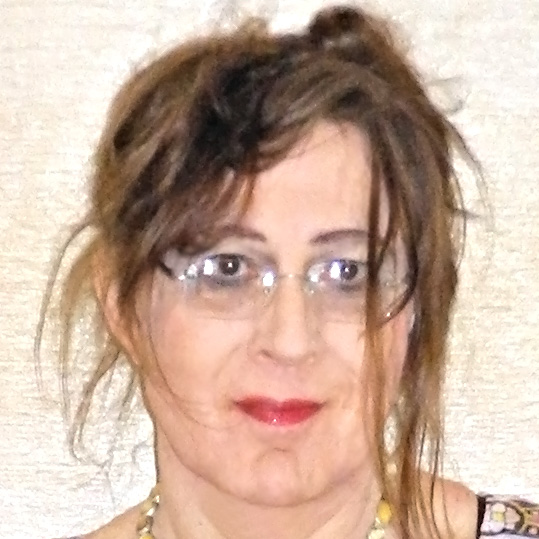
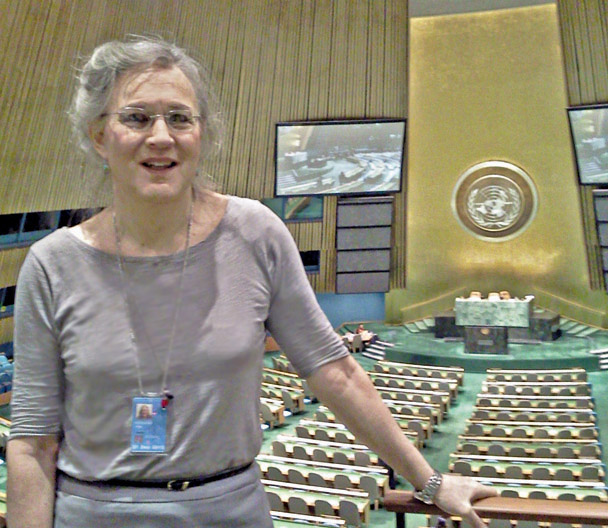


Life, Tools, Arts & What interests me
Odd Notes
One of my main habits is writhing myself margin notes on little scraps of paper,
on all sorts of subjects. What I have published are in my
OddNotes directory . A sample is my May 2009
hand written notes and
selected transcriptions
Desktop
Photo Collection
(go to web albums for large images formatted normal & wide)
(F11 to view full screen)..
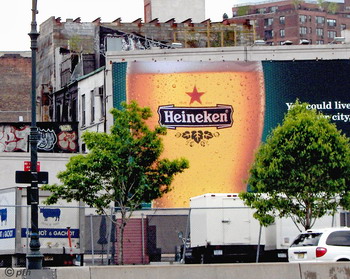
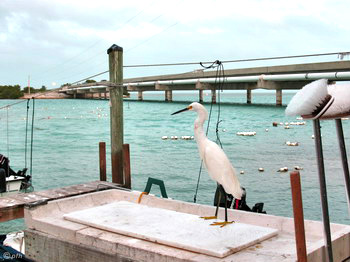 NYCity &
Florida
NYCity &
Florida

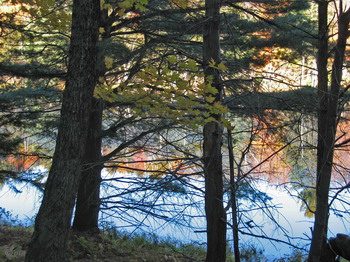 Flora &
Country
Flora &
Country
Interesting fantasy
stories by a young writer (Jonathan H. - at 11)
A
question
concerning the nature of change, ...
3/22/01
I
used to paint some, this in from about 1985,
called 'ManOnEarth'
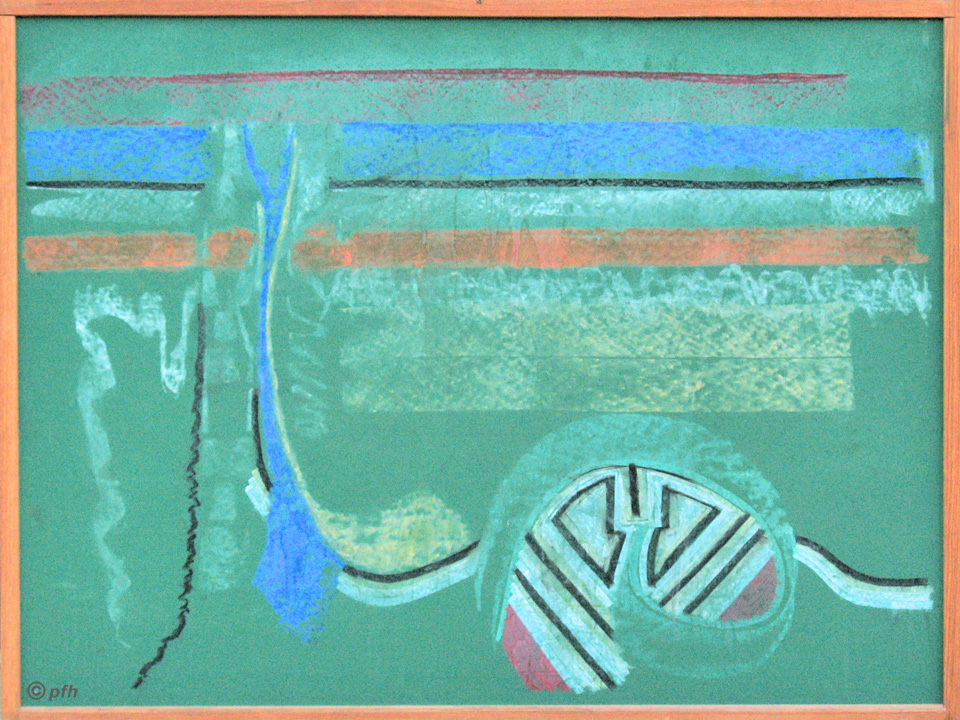
Tools and things
10/2000 to 7/02/06 Natural
science has long been my actual main work, which I've supported with
architectural design. Occasionally both have been worth all the trouble
it takes to do them well. I’m presently responsible for finishing
the public spaces design and detailing all of a $110 million US courthouse for
Jackson Mississippi. Other recent architectural work includes significant roles in the design of
New York's Bronx Botanic Garden visitor's center, Science, Industry
& Business public library (SIBL), the Grand Central terminal
renovation, reconstructing St. Agnes cathedral, renovating the
Metropolitan club, Jewish Theological Seminary, the Coney Island
Steeplechase Ball Park, Grand Rapids Public Library, Niagara Gorge visitor
center, SOPAC in South Orange and other
projects. Now I'm working at H3, back with old friends.
It's good work, and nice to have clients that expect
enough to make it fun. I first changed to architecture
when physics didn't satisfy my interest in arts and human values, and was then
brought back to physics when my study of abstract form in air currents led
to finding the curiously obvious unnoticed patterns of locally emergent
systems, an opening to the great questions and contradictions of science
and nature.
My
major work is on the physics of natural learning systems, called
a physics of
happening. I think my two principle
contributions are a reliable method of identifying
emergent natural systems, and using the tools of physics backwards to
study them. I use the same mathematical and logical tools
as physics, but to detect and watch events develop in the things
themselves, carefully exploring autonomous and unstable systems
rather than making simplified models of them. In the
case of natural learning systems it seems all models are simplistic.
I've
always loved a good shop and tools, with large and small piles of sawdust
and metal shavings. Now I just use a computer (well,..
and occasionally get to fix things). I also write a little. I
guess, other than my guiding loves, my
greatest pleasure when I was young was skiing and as an adult the endless
hours of reading to my son and guiding him and his friends in new
experience.
Software tools,
AutoLisp is the text programming language
of AutoCAD, a widely used graphical database for engineering,
manufacturing and design. Macro is a library of general
purpose drawing utilities and productivity tools. Curve is the
library of analytical tools used in derivative reconstruction.
I'm trying to convert to R but it's slow doing it by myself with lots of other things
to do too, so it probably won't happen till I get some help. The
AutoCAD platform is missing many valuable statistical tools but also does
things that simply can't be done in conventional statistical packages,
like record the history of one's successive treatments of a data set, or
use data sets with irregular time lines as variables in data equations....
A question
ed 3/22/01
...any physical event,
a wink or a collapsing star, is a chain of
natural events combining a myriad of others spanning a tremendous range of
scales, propagating multiplying effects in flowing patterns, taking time and
development to proceed. Mathematics isn't what is happening,
though that's one of the best tools we have for describing it. The
scientific name for it is 'local emergence' [well,
not the
Santa Fe
variety, ed.2/06]. It's so much a part of events might we also just
call it 'change', or 'happening'?
Does all change Evolve?
Take the formation of
a crystal. It begins small, around some seed, and proceeds at an increasing
speed as the crystallization fringe expands, first more and then less rapidly,
until it approaches its natural limit. Then there's a crystal, a new steady state,
the result of a swelling and waning pattern of history dependent events, a
flow. This same general acceleration and climaxing sequence is evident in
complex successions of innumerable kinds, and may be present in change
universally. Some of its parts are always strictly local in origin
and action. Everything that happens seems to happen that very same
way, so why's it a mystery?
These chains of events follow a strict
sequence, speeding up and then slowing down. They absolutely never
start in the middle, with slowing down for example, but always start at the
beginning of the succession and end at the natural succession's end. No
matter what you do you can't get either a physical or intellectual model of a
process of change to work properly without the tell-tale these
little start-up and shut-down sequences that mark its departure from a past
form and a final arrival at a new one.
Scientific tools can partly test the
question by allowing us to take direct measures of change to see if
transitional curves, developing rates, are to be found connecting steady
states. Such growth rate curves are a sign of history dependent processes and
locally developing causation. It is not so much whether a sequence of
measurements fits a growth equation. It's whether there's any process at all
connecting the end points of change. What is commonly found connecting steady
states are the ever-present logistic ('S') curves,
frequently regular, but non-steady state, smooth transitional progressions
connecting changes in kind.
Logistic curves are unusually
pervasive in the measures of transitional events of every scale and duration.
They occur precisely during the time intervals where fundamental change is
occurring, where the past and future formulas do not apply, and where it is
especially hard to describe what's going on. This coincidence is a marvel of
nature that goes relatively unnoticed in the body of science. I don't believe
there is a chapter in any physics text simply called 'change', 'happening' or
its equivalent. We work around it all the time, but never really address the
subject. The question is, what do those easily
observable orderly in-between periods represent?
Are they the evidence of evolving
systems, exploding and fading successions of events too complex for us to yet
understand, the smooth and silent workings of radical transformation, the
pervasively evident but completely mysterious way it all works?
continued
jlh
 If you're a researcher
interested in visiting, to
work in my
library, I have great collection of books on numerous related fields. include eds. 3/22/01
3/9/04,05,06,07,08,09,
1/21/10 1/23 2/6 7/5 11/28
1/14/11 4/11 10/11 06/15 (note other ed.
dates indicate revisions of history of paragraphs or sections are) (P.F. Henshaw is the
pen name of Jessie Henshaw)
If you're a researcher
interested in visiting, to
work in my
library, I have great collection of books on numerous related fields. include eds. 3/22/01
3/9/04,05,06,07,08,09,
1/21/10 1/23 2/6 7/5 11/28
1/14/11 4/11 10/11 06/15 (note other ed.
dates indicate revisions of history of paragraphs or sections are) (P.F. Henshaw is the
pen name of Jessie Henshaw) 






 9/2/10
The curves at the left demonstrate
the oddly ignored 150 year old observation of Stanley Jevons, that
improving efficiency results in accelerating resource use.
He first noticed it in how improving efficiency for steam engines used
up coal faster. The problem is we mostly use efficiencies to simplify our tasks
and so make resource use more profitable, to become more affluent.
The "secret" of how it works is that the particular efficiencies we
choose to invest in are the very ones that for a small cost have the
effect of simplifying a whole system of parts, often with improved technology.
That causes an increased productivity of the whole greater than the
decreased needs of the more efficient part. That's called growth,
the redesign of production systems so they can use and consume more.
To achieve the opposite effect and be responsive to our strains on the
environment we'd need to bring growth to an end, rather than accelerate
it with more efficiency... We've let ourselves be misled, in
part, and stumbled into a natural misunderstanding much like early
doctors who applied leaches to remove a patient's "bad blood".
By believing that sort of myth for too long we're now slipping into
grave danger of creating development we'll soon be unable to
either maintain or replace, and a physical system bankruptcy of a
lasting kind. (...
9/2/10
The curves at the left demonstrate
the oddly ignored 150 year old observation of Stanley Jevons, that
improving efficiency results in accelerating resource use.
He first noticed it in how improving efficiency for steam engines used
up coal faster. The problem is we mostly use efficiencies to simplify our tasks
and so make resource use more profitable, to become more affluent.
The "secret" of how it works is that the particular efficiencies we
choose to invest in are the very ones that for a small cost have the
effect of simplifying a whole system of parts, often with improved technology.
That causes an increased productivity of the whole greater than the
decreased needs of the more efficient part. That's called growth,
the redesign of production systems so they can use and consume more.
To achieve the opposite effect and be responsive to our strains on the
environment we'd need to bring growth to an end, rather than accelerate
it with more efficiency... We've let ourselves be misled, in
part, and stumbled into a natural misunderstanding much like early
doctors who applied leaches to remove a patient's "bad blood".
By believing that sort of myth for too long we're now slipping into
grave danger of creating development we'll soon be unable to
either maintain or replace, and a physical system bankruptcy of a
lasting kind. (... C
C Physics
of
Natural Open Systems
Physics
of
Natural Open Systems
 "canonical
development trajectory" was also described by
"canonical
development trajectory" was also described by
 T
T 12/28/08
1/24/09 1/27 1/20/10
12/28/08
1/24/09 1/27 1/20/10  familiar compound investment function
of using something that was built to build more, using success to leverage
growing success. Every organized system in
nature actually begins with a relatively 'long habit' of doing that,
but then changes. The change happens at a point of
diminishing returns, a declining net productivity for investment (declining
success in multiplying) at some point. What businessmen normally do when
that happens in a single business is divert the returns for the business
away from reinvestment, doing something else with them. It turns
their business into a sustainable "cash cow" to support other interests or help
build compounding investment in other things.
familiar compound investment function
of using something that was built to build more, using success to leverage
growing success. Every organized system in
nature actually begins with a relatively 'long habit' of doing that,
but then changes. The change happens at a point of
diminishing returns, a declining net productivity for investment (declining
success in multiplying) at some point. What businessmen normally do when
that happens in a single business is divert the returns for the business
away from reinvestment, doing something else with them. It turns
their business into a sustainable "cash cow" to support other interests or help
build compounding investment in other things.
 When diminishing returns occur
for an economy as a whole its seen as meeting natural resistance, in steeper
learning curves, shortages causing higher prices and erupting internal and
external conflicts, throughout the whole system at once. Nature is
sending the same signal
for the system as a whole that peak development in an individual business
indicates, that increasing investment is decreasingly productive.
It then decreases the productivity of investment to continue multiplying
investment, heading toward a point of whole system climax where the
productivity of investment comes to zero. It could not get there, of
course, since zero return financial systems would not be stable.
When diminishing returns occur
for an economy as a whole its seen as meeting natural resistance, in steeper
learning curves, shortages causing higher prices and erupting internal and
external conflicts, throughout the whole system at once. Nature is
sending the same signal
for the system as a whole that peak development in an individual business
indicates, that increasing investment is decreasingly productive.
It then decreases the productivity of investment to continue multiplying
investment, heading toward a point of whole system climax where the
productivity of investment comes to zero. It could not get there, of
course, since zero return financial systems would not be stable.
 at an ever faster pace.
Growth for us has been very rewarding for around 600 hundred years.
Slow accumulation, using success to build on success over the long haul, has
produced a very dramatic change in the promise of human
history. Past performance, as they say, is no guarantee of
future returns though. That's especially the case in humanity's
clear diminishing net returns on investing in the earth. The
benefit/cost ratio is simply not what it was.
In order for the economy to climax the amount of investment needs to
climax. That's possible either at a healthy high level or after collapsing and returning human culture to a new era
of feudalism. It only depends on how persistent we are at
compounding our errors.
at an ever faster pace.
Growth for us has been very rewarding for around 600 hundred years.
Slow accumulation, using success to build on success over the long haul, has
produced a very dramatic change in the promise of human
history. Past performance, as they say, is no guarantee of
future returns though. That's especially the case in humanity's
clear diminishing net returns on investing in the earth. The
benefit/cost ratio is simply not what it was.
In order for the economy to climax the amount of investment needs to
climax. That's possible either at a healthy high level or after collapsing and returning human culture to a new era
of feudalism. It only depends on how persistent we are at
compounding our errors.  -7/6/10
Ants seem to rub antenna just the way people shake hands, i.e. quite
expertly and without thinking about it, for mutual recognition of complex
relationships... Wow! Those simplest of gestures
between animate beings, mutual homing of independent systems, a smile, a
kiss, responsiveness without analysis, a dance with a partner experienced as
becoming one. I don't think it'll ever quite make rational
sense, or be possible to program for inanimate beings. Is there
a difference between a "squeeze" and a "hug" ? Yes, most
definitely.
-7/6/10
Ants seem to rub antenna just the way people shake hands, i.e. quite
expertly and without thinking about it, for mutual recognition of complex
relationships... Wow! Those simplest of gestures
between animate beings, mutual homing of independent systems, a smile, a
kiss, responsiveness without analysis, a dance with a partner experienced as
becoming one. I don't think it'll ever quite make rational
sense, or be possible to program for inanimate beings. Is there
a difference between a "squeeze" and a "hug" ? Yes, most
definitely.











